The Giants take on the Packers (3-1) in London on Sunday. After losing their season opener, the Packers have won three straight games, including an overtime 27-24 victory at home against the Patriots in Week 4.
When the Packers have the ball…
1. Aaron Rodgers is still the Packers quarterback but their offense has evolved to focus around the running game. The Packers rank 10th in the NFL in overall run rate (44.8%) with their run tendencies hovering around the same rank on 1st-and-10 and in first halves of games. They want to run the ball.
AJ Dillon has nine more carries than Aaron Jones this season, even though Jones has 126 more yards. Dillon is a bruising 250-pound back who is difficult to bring down between the tackles, and will move the pile forward. He is only averaging 3.7 yards per carry and has only four runs of 10+ yards this season, but he can grind down a defense, especially late in games. Jones is the more versatile weapons with 12 catches to go along with his 48 carries this season. He is averaging 6.81 yards per carry with 12 runs of 10+ yards. According to Pro Football Focus, Jones has forced 18 missed tackles this season, which ranks fourth in the NFL. His forced missed tackle rate of .37 ranks second to Nick Chubb in the NFL.
The Packers are seventh in the NFL in rush yards per game (145) and are tied for fifth with 18 runs of 10+ yards. Green Bay has not been a proficient first-down team, averaging only 5.24 yards per play (24th).
2. There is a large discrepancy between where the Packers rank in yards per game (377.5 – sixth) and in points per game (18.8 – tied for 21st). The answer can be found in two different areas. The Packers are last in goal-to-go situations, scoring only one touchdown on three chances inside the 10. Outside the red zone, they have been limited to one field goal.
The Packers have been strong on third downs, converting 42.6% (ninth), but have turned it over seven times this season (-3 turnover ratio) including one giveaway in goal-to-go situations. The Packers' 13.3% offensive DVOA ranks eighth in the NFL, according to Football Outsiders.
3. Aaron Rodgers is completing 69% of his passes for 233.8 yards with six touchdowns and three touchdowns. PFF tracks what they consider "big-time throws" and he ranks third (6.1%) among those with at least 25 attempts.
Some of the advanced metrics tell different stories: Via ESPN, his 43.1 QBR ranks 22nd in the NFL and his EPA (expected points added) of 10.6 ranks 23rd. NFL's NextGenStats keeps track of CPOE (completion percentage above expectation), where Rodgers ranks third (+2.6%) and his PFF passing grade is seventh.
Without go-to wide receiver Davante Adams on the roster and the departure of Marquez Valdes-Scantling, Rodgers has had to spread the wealth. He has completions to six different receivers - none of who have more than 19 receptions. Rookie fourth-round pick Romeo Doubs leads the team with 19 catches for 184 yards and two touchdowns. Allen missed Week 1 due to injury and has 12 catches for 174 yards and two touchdowns. Old reliable Randall Cobb is still Rodgers' slot receiver/security blanket and he has 10 catches for 150 yards. Sammy Watkins is out with a hamstring injury, so the Packers lack a true game-breaking threat at receiver. Tight end Robert Tonyan is second on the team with 13 receptions. The Packers play with two tight ends with one running back (12 personnel) on 31.1% of their snaps, but their most common personnel group features one running back and three wide receivers (11 personnel), which they use 52% of the time.
The Packers' passing game has relied on yards after the catch more than any other NFL team. Their 496 yards after the catch leads the NFL and they are tied for second in pass plays that go for at least 20 yards (17). However, Rodgers has a passer rating of just 42.4 on passes that travel 20+ yards in the air. Rodgers has faced pressure on only 25% of his dropbacks, which is the third-lowest rate in the NFL. He helps his line with his 2.48-second average time to throw, which ranks fourth, according to PFF. Rodgers also has a stellar 121.53 QB rating against the blitz.
The offensive line has dealt with injuries for much of the season. Elgton Jenkins missed Week1 and has started at right tackle since. David Bakhtiari has played the last two games at left tackle after missing the first two games. Jon Runyan and Royce Newman are the guards with Josh Myers at center. According to PFF, Jenkins and Newman have each allowed two sacks, with Jenkins allowing a team-high nine pressures and Newman eight. The Patriots pressured Rodgers often in the first half last week, managing pressures on six of Rodgers' 13 dropbacks.
Keys for the Giants' defense
* Limit big plays from Aaron Jones
* Tackle well to prevent Packers yards after the catch
* Don't present Rodgers with too many easy 1-on-1 situations vs. the blitz
View rare photos of the history between the New York Giants and Green Bay Packers.


New York Giants Benjamin Friedman is stopped after making a 10-yard gain against the Green Bay Packers during a football game at the Polo Grounds in New York City. (AP Photo)

New York Giants Hall of Fame fullback Alphonse "Tuffy" Leemans (4) scores the first touchdown, on a 6 yard carry, in a 17 to 23 victory over the Green Bay Packers in the 1938 NFL Championship played on Dec.11, 1938 at the Polo Grounds in New York.(Pro Football Hall of Fame via AP Images)

Cecil Isbell (17), Green Bay halfback, hits the line for a ten-yard gain in the first quarter at the Polo Grounds as the New York Giants defeated the Green Bay Packers in their National Professional Football game in New York, Nov. 20, 1938. (AP Photo)

The New York Giants defeated the Green Bay Packers, 15-3, in a muddy NFL game at the Polo Grounds in New York, Nov. 20, 1938. Ed Jankowski (7), of the Packers, gains 4 yards on a reverse play in the 1st quarter after his teammate Cecil Isbell (17) gave him the handoff. Ken Lunday (5), Giants guard, is attempting to tackle Jankowski with Henry Bruder (5) running interference for his Green Bay teammate. The Giant player in foreground is Jim Lee Howell (21). (AP Photo)

Only two feet short of a touchdown, Green Bay Packers Clarke Hinkle is shown as he was halted by the New York Giants in the second period of their championship game with the Packers, Dec. 11, 1938 in New York. The Giants won, 23 to 17. Other Packers players shown include Bud Svendsen (53); Cecil Isbell (17); and Bill Lee (40). (AP Photo)

Quarterback Cecil Isbell of the Green Bay Packers is stopped by New York Giants' Frank Cope after a two- yard gain in NFL title game at the State Fair Grounds in Milwaukee, Wisc., Dec. 11, 1939. The Packers won, 27-0, before a crowd of 32, 000 for the National Football League championship. (AP Photo)
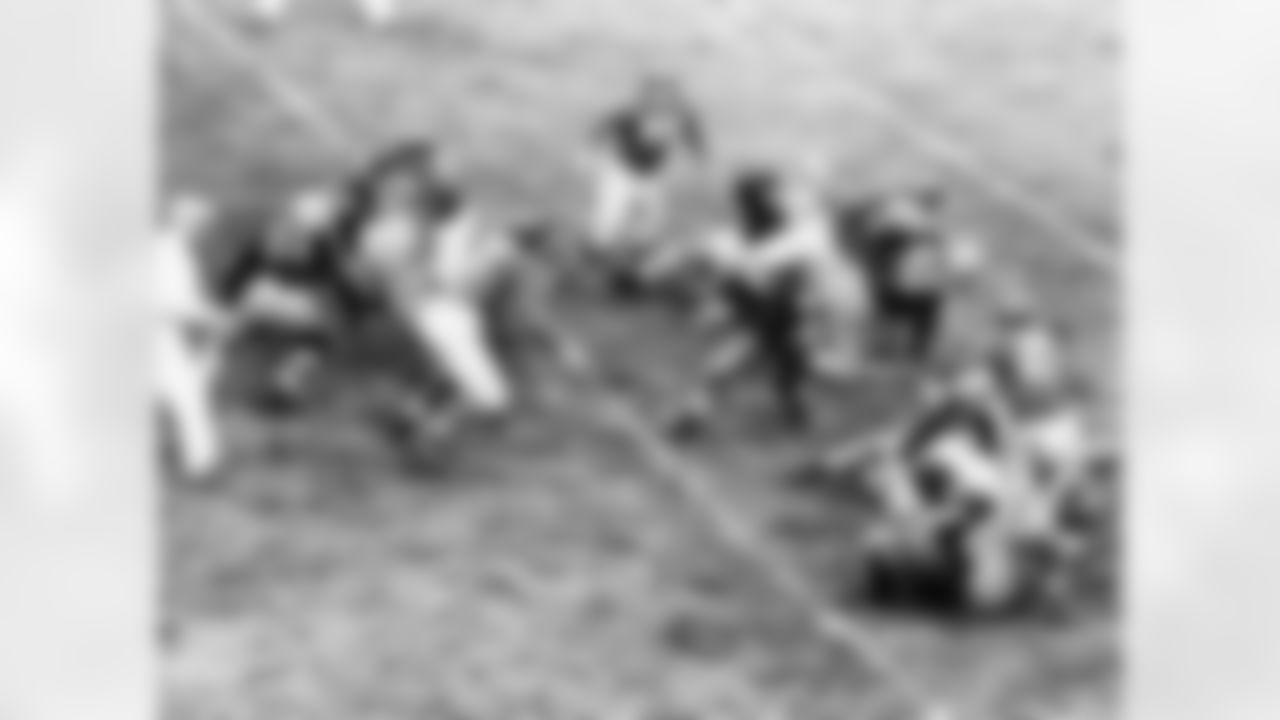
Andy Uram of the Green Bay Packers cracks through a hole in the center of the line to run smack into Mel Hein (7) New York Giants center, in the first quarter of a National Professional Football League game in New York City, Nov. 17, 1940. Uram made just one yard on the play. The Giants won, 7-3. Identifiable players: Packers Pete Tinsley (21) guard Bill Lee (40) tackle and George Svendsen (66) center; Giants Jim Poole (23) end. (AP Photo)

Green Bay Packers halfback Al Carmichael (48) runs upfield during an NFL game against New York Giants at County Stadium in Green Bay, 1950s. (AP Photo/Vernon Biever)

Green Bay Packers halfback Al Carmichael (42) runs upfield during an NFL game against the New York Giants at County Stadium, 1950s. (AP Photo/Vernon Biever)

Green Bay Packers quarterback Vito "Babe" Parilli (10) runs upfield during an NFL game against the New York Giants in Green Bay, Nov. 3, 1957. The Giants defeated the Packers 31-17 at the "new" City Stadium. (AP Photo/Vernon Biever)

New York Giants Hall of Fame halfback Frank Gifford (16) heads upfield during an NFL game against the Green Bay Packers, Nov. 3, 1957. The Giants defeated the Packers 31-17 at Milwaukee County Stadium. (AP Photo/NFL Photos/Vernon Biever)
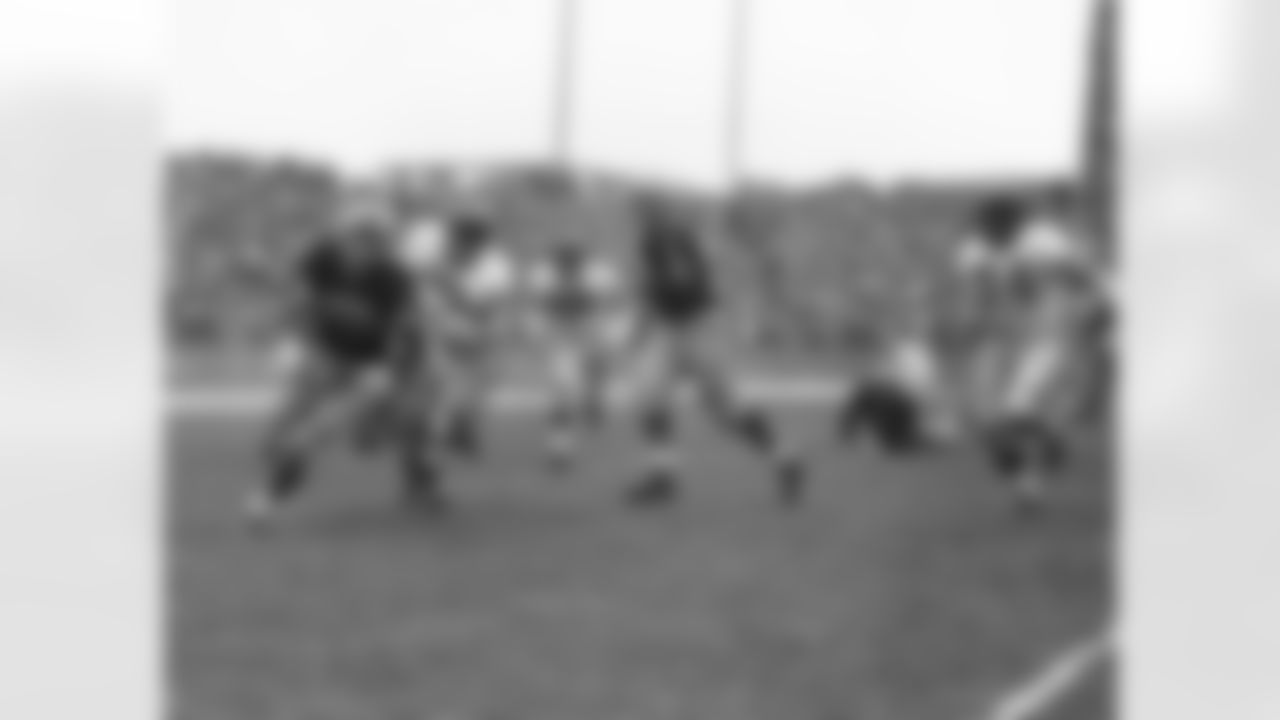
Green Bay Packers halfback Don McIlhenny (42) rushes the ball as he is pursued by New York Giants defensive end John Martinkovic (83) during an NFL game Nov. 3, 1957, Green Bay, Wisc. (Vernon J. Biever via AP)

New York Giants Hall of Fame linebacker Sam Huff looks to the officials during an NFL game against the Green Bay Packers in New York, in the 1960s. Exact date is unknown. (AP Photo/Vernon Biever)

Halfback Paul Hornung of the Green Bay Packers holds onto the ball as tacklers of the New York Giants try to bring him down in a 0 to 37 win in the 1961 NFL Championship on December 31, 1961 at Lambeau Field in Green Bay, Wisconsin.(AP Photo/Vernon Biever)

Green Bay Packers Hall of Fame running back Paul Hornung (5) throws a pass on a halfback option during the 1961 NFL Championship Game against the New York Giants in Green Bay. Wis., Dec. 31, 1961. The Packers defeated the Giants 37-0. (AP Photo/Vernon Biever)
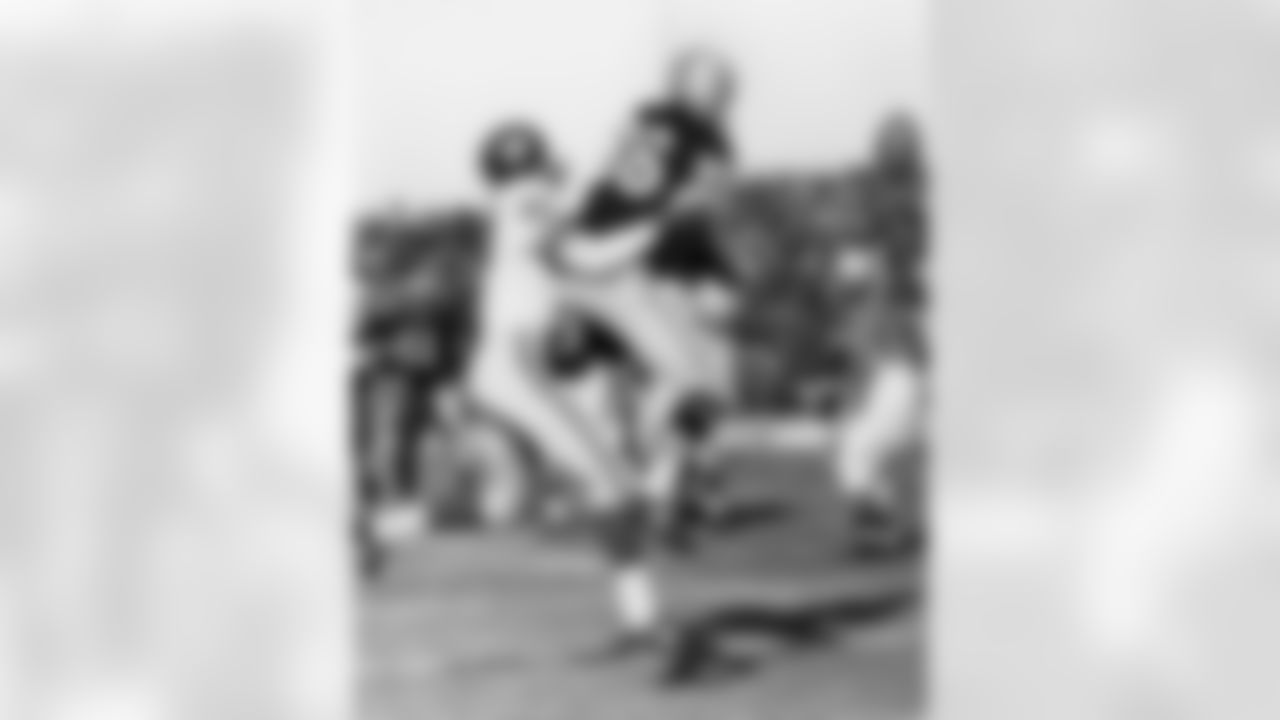
New York Giants cornerback Erich Barnes (49) defends a pass intended to wide receiver Boyd Dowler (86) during the 1961 NFL Championship Game in Green Bay, Wis., Dec. 31, 1961 The Packers defeated the Giants 37-0. (AP Photo/Vernon Biever)

New York Giants' linebacker Sam Huff (70) puts his crushing hug on Green Bay Packers' Jim Taylor (31), Sept. 4, 1962, in Green Bay, Wisconsin. The Packers won, 20-17. (AP Photo)

Green Bay fullback Jim Taylor tries to swing clear of Giants tackler but is stopped for no gain during first half of the NFL title game at Yankee Stadium in New York, Dec. 30, 1962. Identifiable players are Fred Thurston (63) of Green Bay, and Dick Modzelewski (77) of the Giants. (AP Photo)

Green Bay Packers' fullback Jim Taylor (31) takes to the air as he goes through the New York Giants defense for a five-yard gain in third period of NFL championship game at New York's Yankee Stadium, Dec. 30, 1962. Identifiable Packers are Fred Thurston (63), Norm Masters (78) and Jim Ringo 951). Giants are Andy Robustelli (81), Dick Modzelewski (77) and Sam Huff (70). Green Bay won, 16-7. (AP Photo)

New York Giants defensive tackle Rosey Grier (76) stops Green Bay Packers Hall of Fame fullback Jim Taylor (31) during the 1962 NFL Championship Game in New York, Dec. 30, 1962. The Packers defeated the Giants 16-7. (AP Photo/Vernon Biever)

Del Shofner of the New York Giants makes a catch against the Green Bay Packers in a 16-7 loss in the 1962 NFL Championship on December 30, 1962 at Yankee Stadium in New York, New York. (AP Photo/Vernon Biever)

Green Bay Packers tackle Norm Masters (78) blocks New York Giants Hall of Fame defensive end Andy Robustelli (81) while defensive tackle Rosey Grier (76) wallops Green Bay Packers Hall of Fame quarterback Bart Starr (15) during the 1962 NFL Championship Game in New York., Dec. 30, 1962. The Packers defeated the Giants 16-7. (AP Photo/Vernon Biever)
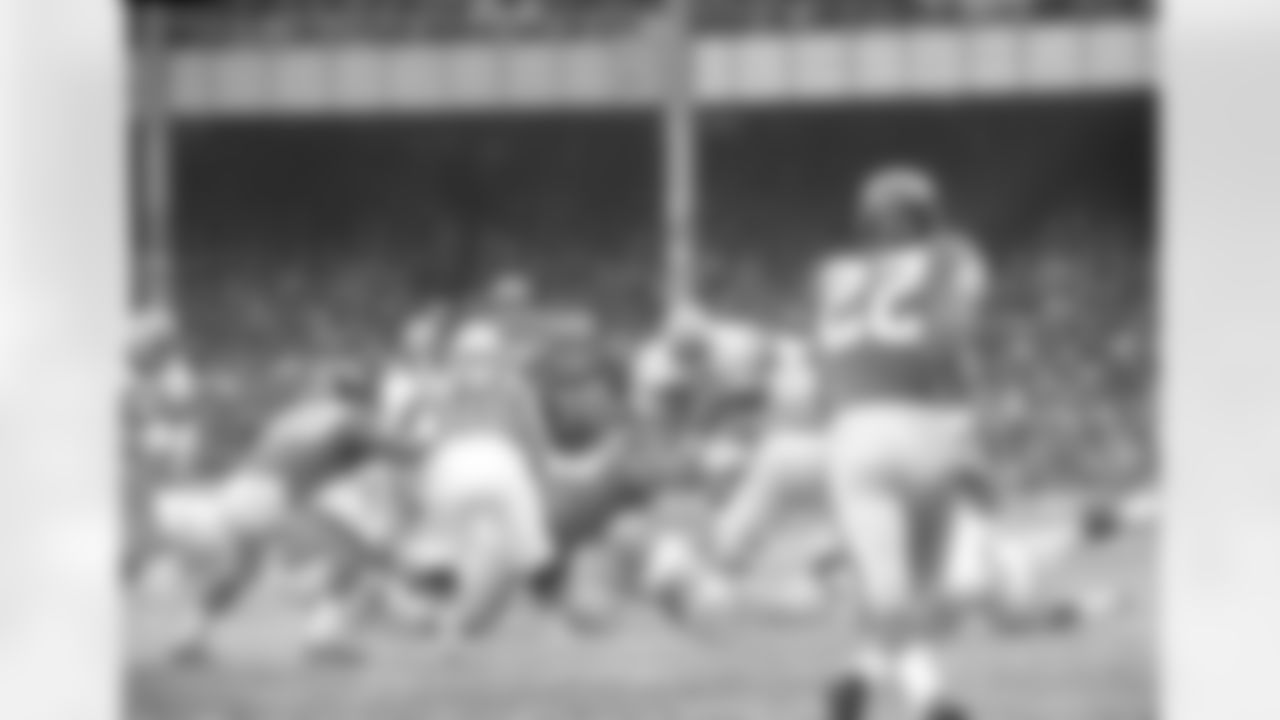
Green Bay fullback Jim Taylor (31) rams through center of Giants line for five yards in the first half of NFL title game at Yankee Stadium, Dec. 30, 1962., Blocking for him is Jim Ringo (51). Giant defenders are Jimmy Patton (20), Jim Katcavage (75), Sam Huff (70), Rosey Grier (76) and Dick Lynch (22). Packers win, 16-7. (AP Photo)

Del Shofner the New York Giants is tackled by Herb Adderley and Willie Wood of the Green Bay Packers in a 16-7 loss in the 1962 NFL Championship on December 30, 1962 at Yankee Stadium in New York, New York. (AP Photo/Vernon Biever)

New York Giants Hall of Fame quarterback Fran Tarkenton (10) sets up to pass during an NFL game against the Green Bay Packers in New York, Nov. 22, 1967. The Packers defeated the Giants 48-21. (AP Photo/Vernon Biever)

Dragging two New York Giants' defenders with him, Green Bay Packers half back Elijah Pitts (22) scores a touchdown from the 10 yard line in the third quarter of the game with the Giants at Yankee Stadium on Oct. 22, 1967. Defenders are Wendell Harris (22), left, and Vince Costello (57). Packers won 48-21. (AP Photo)

New York Giants Quarterback Fran Tarkenton (10), tries to get a pass off in the first quarter of a game against the Green Bay Packers Oct. 22, 1967 at Yankee Stadium in the Bronx, New York. Pursuing Tarkenton are Packer defenders Willie Davis (87) and Lionel Aldridge (82) Willie Young (69) of the Giants trails at right. Packers won 48-21. (AP Photo)

Green Bay Packers back Elijah Pitts slams across the goal line to score in first period of game with New York Giants at Yankee Stadium on Oct. 22, 1967 in New York. Identifiable giant defenders are Scott Eaton (20) and Wendell Harris (26). Packers won, 48-21. (AP Photo)

The New York Giants Hall of Fame quarterback Fran Tarkenton (10) prepares to take the snap from center Greg Larson (53) during an NFL game against the Green Bay Packers in Green Bay, Sept. 19, 1971. The Giants defeated the Packers 42-40. (AP Photo/Vernon Biever)

New York Giants Hall of Fame quarterback Fran Tarkenton (10) eludes Green Bay Packers defensive end Alden Roche (87) during an NFL game at Green Bay, Sept. 19, 1971. Tarkenton passed for 236 yards and four touchdowns in the Giants 42-40 win over the Packers. (AP Photo/Vernon Biever)

Brad van Pelt (10) of the New York Giants leaps to block a second quarter field goal attempt by the Green Bay Packers Jan Stenerud during their game at East Rutherford, N.J., Sept. 20, 1982. (AP Photo/Ron Frehm)

Green Bay Packers wide receiver John Jefferson (83) is wrapped up by New York Giants defensive back Bill Curry (29) during an NFL game, Nov. 8, 1981. The Packers defeated the Giants 26-24 at Milwaukee County Stadium. (AP Photo/Vernon Biever)

New York Giants kicker Ali Haji-Sheikh (6) and quarterback Scott Brunner (12) watches his field goal attempt during an NFL game against the Green Bay Packers in East Rutherford on September 26, 1983. The Giants defeated the Packers 27-3. (AP Photo/Chuck Solomon)

New York Giants running back Rob Carpenter (26) is met by Green Bay Packers linebacker Rich Wingo (50) during an NFL game in East Rutherford on September 26, 1983. The Giants defeated the Packers 27-3. (AP Photo/Chuck Solomon)

New York Giants tight end Mark Bavaro (89) catches a touchdown pass while covered by Green Bay Packers defensive back David Greenwood (49) during the NFL game on December 20, 1986 in East Rutherford, New Jersey. The Giants won the game 55-24. (AP Photo/Paul Spinelli)

The New York Giants coach Bill Parcells is the recipient of another container of iced water by the Giants Harry Carson during the last minutes of the 55-24 victory over the Green Bay Packers, Dec. 20, 1986 in East Rutherford. The win gave the Giants the home field for the upcoming post season play. (AP Photo/G. Paul Burnett)

New York Giants cornerback Phillippi Sparks (22) chases the action during the 1995 NFL regular season football game against the Green Bay Packers on Sept. 17, 1995 in Green Bay, Wis. The Packers won the game 14-6. (Paul Spinelli via AP)

New York Giants quarterback Dave Brown (17) throws a pass while being rushed by Green Bay Packers defensive end Reggie White (92) during the 1995 NFL regular season football game against the Green Bay Packers on Sept. 17, 1995 in Green Bay, Wis. The Packers won the game 14-6. (Paul Spinelli via AP)

An official throws a penalty flag while New York Giants quarterback Dave Brown (17) drops back to pass in this overhead general view photograph taken during the NFL football game against the Green Bay Packers on Sept. 17, 1995 in Green Bay, Wis. The Packers won the game 14-6. (Paul Spinelli via AP)

New York Giants strong safety Jesse Campbell (37) leaps while trying to block a field goal attempt by Green Bay Packers kicker Craig Hentrich (17) during the NFL football game against the Green Bay Packers on Sept. 17, 1995 in Green Bay, Wis. The Packers won the game 14-6. (Paul Spinelli via AP)

New York Giants wide receiver Arthur Marshall (86) is chased by Green Bay Packers defensive back LeRoy Butler (36) during the 1995 NFL regular season football game against the Green Bay Packers on Sept. 17, 1995 in Green Bay, Wis. The Packers won the game 14-6. (Paul Spinelli via AP)

Quarterback Dave Brown of the New York Giants (17) calls out signals over the offensive line before the snap of the ball in a 14 - 6 loss to the Green Bay Packers on September 17, 1995 at Lambeau Field in Green Bay, Wisconsin. (AP Photo/Paul Spinelli)

New York Giants running back Rodney Hampton (27) dives for extra yardage while running the ball during the NFL football game against the Green Bay Packers on Sept. 17, 1995 in Green Bay, Wis. The Packers won the game 14-6. (AP Photo/Paul Spinelli)

New York Giants running back Rodney Hampton (27) pushes his way around a block by a New York Giants offensive lineman during the 1995 NFL regular season football game against the Green Bay Packers on Sept. 17, 1995 in Green Bay, Wis. The Packers won the game 14-6. (Paul Spinelli via AP)

New York Giants quarterback Dave Brown (17) throws a pass during the NFL football game against the Green Bay Packers on Sept. 17, 1995 in Green Bay, Wis. The Packers won the game 14-6. (AP Photo/Paul Spinelli)

Jumbo Elliott #76 of the New York Giants blocks against the Green Bay Packers on September 17, 1995 in Green Bay, Wis. The Packers defeated the Giants 14-6. (Joe Robbins via AP)

New York Giants running back Hershel Walker (34) catches the ball during a game against Green Bay Packers in Green Bay, WI, Sep. 17, 1995. The Packers defeated the Giants 14-6. (Paul Spinelli via AP)

New York Giants wide receiver Mike Sherrard (88) carries the ball against the Green Bay Packers in Green Bay, WI, Sep. 17, 1995. The Packers defeated the Giants 14-6. (Paul Spinelli via AP)

Green Bay Packers quarterback Brett Favre (4) pats New York Giants defensive end Michael Strahan (92) after Strahan sacked him for the NFL sack record during the fourth quarter Sunday, Jan. 6, 2002, at Giants Stadium in East Rutherford, N.J. The sack gave Strahan 22.5 sacks for the season surpassing New York Jets Mark Gastineau's NFL record of 22 sacks. Giants defensive tackle Cornelius Griffin (97) congratulates Strahan.(AP Photo/Bill Kostroun)

Green Bay Packers' William Henderson is flipped by New York Giants' Will Peterson (24) on a run in the first half Sunday, Oct. 3, 2004, in Green Bay, Wis. (AP Photo/Darren Hauck)

Tiki Barber of the News York Giants runs for yardage against the Green Bay Packers at Lambeau Field on October 3, 2004. New York won 14-7. (AP Photo/G. Newman Lowrance)

Shaun O'hara of the New York Giants prepares to snap the ball against the Green Bay Packers at Lambeau Field on October 3, 2004. New York won 14-7. (AP Photo/G. Newman Lowrance)

Tiki Barber of the News York Giants runs for a touchdown against the Green Bay Packers at Lambeau Field on October 3, 2004. New York won 14-7. (AP Photo/G. Newman Lowrance)

Terry Cousin of the News York Giants celebrates after making an interception against the Green Bay Packers at Lambeau Field on October 3, 2004. New York won 14-7. (AP Photo/G. Newman Lowrance)

Jeremy Shockey of the New York Giants catches a pass for a touchdown against the Green Bay Packers at Lambeau Field on October 3, 2004. New York won 14-7. (AP Photo/G. Newman Lowrance)

Jeremy Shockey of the New York Giants catches a pass for a touchdown against the Green Bay Packers at Lambeau Field on October 3, 2004. New York won 14-7. (AP Photo/G. Newman Lowrance)

Tiki Barber of the New York Giants runs for yardage against the Green Bay Packers at Lambeau Field on October 3, 2004. New York won 14-7. (AP Photo/G. Newman Lowrance)

Tiki Barber of the News York Giants runs for yardage against the Green Bay Packers at Lambeau Field on October 3, 2004. New York won 14-7. (AP Photo/G. Newman Lowrance)

Ron Dayne of the New York Giants runs for yardage against the Green Bay Packers at Lambeau Field on October 3, 2004. New York won 14-7. (AP Photo/G. Newman Lowrance)

Ike Hilliard of the New York Giants runs after a reception against the Green Bay Packers at Lambeau Field on October 3, 2004. New York won 14-7. (AP Photo/G. Newman Lowrance)

Tiki Barber of the New York Giants runs for yardage against the Green Bay Packers at Lambeau Field on October 3, 2004. New York won 14-7. (AP Photo/G. Newman Lowrance)

New York Giants offensive lineman David Diehl (66) during an NFL football game against the Green Bay Packers at Lambeau Field on October 3, 2004 in Green Bay, Wisconsin. The Giants beat the Packers 14-7. (AP Photo/David Stluka)

New York Giants running back Tiki Barber (21) during an NFL football game against the Green Bay Packers at Lambeau Field on October 3, 2004 in Green Bay, Wisconsin. The Giants beat the Packers 14-7. (AP Photo/David Stluka)

New York Giants defensive lineman Michael Strahan (92) during an NFL football game against the Green Bay Packers at Lambeau Field on October 3, 2004 in Green Bay, Wisconsin. The Giants beat the Packers 14-7. (AP Photo/David Stluka)

New York Giants wide receiver Ike Hilliard (88) during an NFL football game against the Green Bay Packers at Lambeau Field on October 3, 2004 in Green Bay, Wisconsin. The Giants beat the Packers 14-7. (AP Photo/David Stluka)

New York Giants wide receiver Ike Hilliard (88) during an NFL football game against the Green Bay Packers at Lambeau Field on October 3, 2004 in Green Bay, Wisconsin. The Giants beat the Packers 14-7. (AP Photo/David Stluka)

New York Giants tight end Jeremy Shockey (80) during an NFL football game against the Green Bay Packers at Lambeau Field on October 3, 2004 in Green Bay, Wisconsin. The Giants beat the Packers 14-7. (AP Photo/David Stluka)

Quarterback Kurt Warner #13 of the New York Giants hands the ball off to running back Tiki Barber #21 against the Green Bay Packers at Lambeau Field on October 3, 2004 in Green Bay, Wisconsin. The Giants beat the Packers 14-7. (AP Photo/David Stluka)

Defensive lineman Fred Robbins #98 of the New York Giants tackles running back Ahman Green #30 of the Green Bay Packers during an NFL football game for a loss at Lambeau Field on October 3, 2004 in Green Bay, Wisconsin. (AP Photo/David Stluka)

New York Giants tight end Jeremy Shockey (80) during an NFL football game against the Green Bay Packers at Lambeau Field on October 3, 2004 in Green Bay, Wisconsin. The Giants beat the Packers 14-7. (AP Photo/David Stluka)

New York Giants tight end Jeremy Shockey (80) during an NFL football game against the Green Bay Packers at Lambeau Field on October 3, 2004 in Green Bay, Wisconsin. The Giants beat the Packers 14-7. (AP Photo/David Stluka)

New York Giants quarterback Kurt Warner (13) during an NFL football game against the Green Bay Packers at Lambeau Field on October 3, 2004 in Green Bay, Wisconsin. The Giants beat the Packers 14-7. (AP Photo/David Stluka)

New York Giants safety Brent Alexander hits Green Bay Packers receiver Robert Ferguson after making a 24-yard catch in the fourth quarter Sunday, Oct. 3, 2004, in Green Bay, Wis. The Giants won 14-7. (AP Photo/Darren Hauck)

New York Giants' Jeremy Shockey catches a touchdown pass in front of Green Bay Packers' Michael Hawthorne (27) in the fourth quarter Sunday, Oct. 3, 2004, in Green Bay, Wis. The Giants won 14-7. (AP Photo/Morry Gash)

New York Giants safety Gibril Wilson (28) breaks up a pass intended for Green Bay Packers wide receiver Greg Jennings during the first quarter of the NFC Championship football game Sunday, Jan. 20, 2008, in Green Bay, Wis. (AP Photo/David J. Phillip)

GREEN BAY, WI - JANUARY 20: New York Giants and Green Bay Packers players line up at the line of scrimmage prior to the snap during the game between the New York Giants against the Green Bay Packers during the NFC Championship Game at Lambeau Field on January 20, 2008 in Green Bay, Wisconsin. The Giants defeated the Packers 23-20 in overtime.(AP Photo/Scott Boehm)

GREEN BAY, WI - JANUARY 20: Quarterback Eli Manning #10 of the New York Giants celebrates a touchdown against the against the Green Bay Packers during the NFC Championship Game at Lambeau Field on January 20, 2008 in Green Bay, Wisconsin. The Giants defeated the Packers 23-20 in overtime.(AP Photo/Scott Boehm)

GREEN BAY, WI - JANUARY 20: Defensive end Justin Tuck #91 of the New York Giants runs in pursuit against the Green Bay Packers during the NFC Championship Game at Lambeau Field on January 20, 2008 in Green Bay, Wisconsin. The Giants defeated the Packers 23-20 in overtime.(AP Photo/Scott Boehm)

GREEN BAY, WI - JANUARY 20: Running back Ahmad Bradshaw #44 of the New York Giants runs with the football against the Green Bay Packers during the NFC Championship Game at Lambeau Field on January 20, 2008 in Green Bay, Wisconsin. The Giants defeated the Packers 23-20 in overtime.(AP Photo/Scott Boehm)

GREEN BAY, WI - JANUARY 20: Guard Chris Snee #76 of the New York Giants blocks against the Green Bay Packers during the NFC Championship Game at Lambeau Field on January 20, 2008 in Green Bay, Wisconsin. The Giants defeated the Packers 23-20 in overtime.(AP Photo/Scott Boehm)

New York Giants wide receiver Plaxico Burress (17) tries to fend off Green Bay Packers cornerback Al Harris (31) during the NFC Championship football game Sunday, Jan. 20, 2008, in Green Bay, Wis. (AP Photo/David J. Phillip)

GREEN BAY, WI - JANUARY 20: Running back Ahmad Bradshaw #44 of the New York Giants runs with the football against the Green Bay Packers during the NFC Championship Game at Lambeau Field on January 20, 2008 in Green Bay, Wisconsin. The Giants defeated the Packers 23-20 in overtime.(AP Photo/Scott Boehm)

GREEN BAY, WI - JANUARY 20: Defensive end Michael Strahan #92 of the New York Giants runs in pursuit against the Green Bay Packers during the NFC Championship Game at Lambeau Field on January 20, 2008 in Green Bay, Wisconsin. The Giants defeated the Packers 23-20 in overtime.(AP Photo/Scott Boehm)

GREEN BAY, WI - JANUARY 20: Wide receiver Amani Toomer #81 of the New York Giants catches the football for a pass reception against the Green Bay Packers during the NFC Championship Game at Lambeau Field on January 20, 2008 in Green Bay, Wisconsin. The Giants defeated the Packers 23-20 in overtime.(AP Photo/Scott Boehm)

GREEN BAY, WI - JANUARY 20: Wide receiver Amani Toomer #81 of the New York Giants runs a pass pattern against the Green Bay Packers during the NFC Championship Game at Lambeau Field on January 20, 2008 in Green Bay, Wisconsin. The Giants defeated the Packers 23-20 in overtime.(AP Photo/Scott Boehm)

Wide receiver Amani Toomer #81 of the New York Giants makes a diving catch against the Green Bay Packers during the NFC Championship game at Lambeau Field on January 20, 2008 in Green Bay, Wisconsin. The Giants defeated the Packers 23-20 in overtime to advance to Superbowl XLII. (AP Photo/David Stluka)

Defensive back R.W. McQuarters of the New York Giants returns a interception against the Green Bay Packers during the NFC Championship game at Lambeau Field on January 20, 2008 in Green Bay, Wisconsin. The Giants defeated the Packers 23-20 in overtime to advance to Superbowl XLII. (AP Photo/David Stluka)

New York Giant wide receiver Plaxico Burress (17) catches a pass while Green Bay Packers safety Roy Williams (31) tries to block during the NFC Championship football game Sunday, Jan. 20, 2008, in Green Bay, Wis. (AP Photo/David J. Phillip) (AP Photo/David J. Phillip)

New York Giants' Brandon Jacobs (27) runs for a touchdown against the Green Bay Packers during the NFC Championship football game in Green Bay, Wis., Sunday Jan. 20, 2008 (AP Photo/David Duprey)

Running back Brandon Jacobs #27 of the New York Giants lines up in the backfield against the Green Bay Packers during the NFC Championship game at Lambeau Field on January 20, 2008 in Green Bay, Wisconsin. The Giants defeated the Packers 23-20 in overtime to advance to Superbowl XLII. (AP Photo/David Stluka)

New York Giants quarterback Eli Manning looks to throw a pass during the NFC Championship football game against the Green Bay Packers, Sunday, Jan. 20, 2008, in Green Bay, Wis. (AP Photo/David Duprey)

New York Giants' Plaxico Burress (17) attempts a catch under pressure from Green Bay Packers' Atari Bigby (20) during the NFC Championship football game in Green Bay, Wis., Sunday Jan. 20, 2008 (AP Photo/David Duprey)

New York Giants quarterback Eli Manning throws a pass ahead of a rushing Green Bay Packers defensive end Kabeer Gbaja-Biamila during the NFC Championship football game Sunday, Jan. 20, 2008, in Green Bay, Wis. (AP Photo/Jeff Roberson)

Green Bay Packers quarterback Brett Favre (4) looks to hand the ball off in front of New York Giants defensive tackle Jay Alford (93) during the first half of the NFC Championship football game Sunday, Jan. 20, 2008, in Green Bay, Wis. (AP Photo/Mike Roemer)

New York Giants quarterback Eli Manning looks to throw a pass as he runs from Green Bay Packers defensive end Cullen Jenkins (77) during the NFC Championship football game, Sunday, Jan. 20, 2008, in Green Bay, Wis. (AP Photo/David Duprey)

Green Bay Packers' Atari Bigby tries to stop New York Giants' Ahmad Bradshaw (44) as a penalty flag flies during the NFC Championship football game Sunday, Jan. 20, 2008, in Green Bay, Wis. (AP Photo/Jeff Roberson)

New York Giants quarterback Eli Manning throws a pass in front of Green Bay Packers defensive end Aaron Kampman during the NFC Championship football game Sunday, Jan. 20, 2008, in Green Bay, Wis. (AP Photo/Jeff Roberson)

New York Giants kicker Lawrence Tynes (9) celebrates after kicking the game-winning field goal in overtime during the NFC Championship football game against the Green Bay Packers, Sunday, Jan. 20, 2008, in Green Bay, Wis. The Giants won 23-20 and advance to the Super Bowl against the New England Patriots. (AP Photo/David J. Phillip)

New York Giants kicker Lawrence Tynes (9) celebrates with teammates after kicking a field goal in overtime during the NFC Championship football game against the Green Bay Packers, Sunday, Jan. 20, 2008, in Green Bay, Wis. The Giants won 23-20 and advance to the Super Bowl against the New England Patriots. Giants' Michael Strahan is at right. (AP Photo/David J. Phillip)

New York Giants kicker Lawrence Tynes (9) misses a field goal at the end of regulation during the NFC Championship football game against the Green Bay Packers, Sunday, Jan. 20, 2008, in Green Bay, Wis. (AP Photo/David J. Phillip)

New York Giants kicker Lawrence Tynes (9) celebrates with holder Jeff Feagles after kicking the winning field goal in overtime during the NFC Championship football game against the Green Bay Packers, Sunday, Jan. 20, 2008, in Green Bay, Wis. The Giants won 23-20 and advance to the Super Bowl against the New England Patriots. (AP Photo/David J. Phillip)

New York Giants quarterback Eli Manning celebrates after his team's 23-20 overtime win over the Green Bay Packers in the NFC Championship football game Sunday, Jan. 20, 2008, in Green Bay, Wis. (AP Photo/David Duprey)

New York Giants kicker Lawrence Tynes (9) kicks the game-winning field goal in overtime during the NFC Championship football game against the Green Bay Packers, Sunday, Jan. 20, 2008, in Green Bay, Wis. The Giants won 23-20 and advance to the Super Bowl against the New England Patriots. (AP Photo/David J. Phillip)

New York Giants cornerback Corey Webster (23) runs from Green Bay Packers wide receiver Donald Driver (80) after intercepting a pass in overtime during the NFC Championship football game Sunday, Jan. 20, 2008, in Green Bay, Wis. The Giants won 23-20. (AP Photo/Mike Roemer)

New York Giants wide receiver Steve Smith catches a pass with Green Bay Packers cornerback Charles Woodson (21) defending during the second half of the NFC Championship football game Sunday, Jan. 20, 2008, in Green Bay, Wis. (AP Photo/David J. Phillip)

GREEN BAY, WI - JANUARY 20: Tackle Kareem McKenzie #67 of the New York Giants blocks against the Green Bay Packers during the NFC Championship Game at Lambeau Field on January 20, 2008 in Green Bay, Wisconsin. The Giants defeated the Packers 23-20 in overtime.(AP Photo/Scott Boehm)

New York Giants wide receiver Plaxico Burress, left, catches a pass in front of Green Bay Packers cornerback Al Harris (31) during the first half of the NFC Championship football game Sunday, Jan. 20, 2008, in Green Bay, Wis. (AP Photo/David J. Phillip)

New York Giants quarterback Eli Manning (10) looks on as the Green Bay Packers defense stops Giants running back Brandon Jacobs during a first half run in the NFC Championship football game Sunday, Jan. 20, 2008, in Green Bay, Wis. (AP Photo/Jeff Roberson)

New York Giants running back Ahmad Bradshaw (44) tries to break a tackle by Green Bay Packers safety Atari Bigby, left, and Ryan Pickett, rear, during the second half of the NFC Championship football game Sunday, Jan. 20, 2008, in Green Bay, Wis. (AP Photo/David J. Phillip)

New York Giants running back Brandon Jacobs (27) tries to break a tackle by Green Bay Packers cornerback Charles Woodson during the first half of the NFC Championship football game Sunday, Jan. 20, 2008, in Green Bay, Wis. (AP Photo/David Duprey)

New York Giants wide receiver Victor Cruz reacts after making a reception during the first the first half of an NFL divisional playoff football game against the Green Bay Packers Sunday, Jan. 15, 2012, in Green Bay, Wis. (AP Photo/Darron Cummings)

New York Giants kicker Lawrence Tynes (9) kicks an extra point at the end of the first half during an NFL divisional playoff football game against the Green Bay Packers on January 15, 2012 in Green Bay, Wisconsin. The Giants won 37-20. (AP Photo/David Stluka)

New York Giants running back Brandon Jacobs (27) carries the ball during an NFL divisional playoff football game against the Green Bay Packers on January 15, 2012 in Green Bay, Wisconsin. The Giants won 37-20. (AP Photo/David Stluka)

New York Giants quarterback Eli Manning (10) throws a pass during an NFL divisional playoff football game against the Green Bay Packers on January 15, 2012 in Green Bay, Wisconsin. The Giants won 37-20. (AP Photo/David Stluka)

New York Giants quarterback Eli Manning (10) throws a pass during an NFL divisional playoff football game against the Green Bay Packers on January 15, 2012 in Green Bay, Wisconsin. The Giants won 37-20. (AP Photo/David Stluka)

New York Giants defensive end Osi Umenyiora (72) during an NFL football game against the Green Bay Packers on Sunday January 15, 2012 at Lambeau Field in Green Bay, Wisconsin (AP Photo/Evan Pinkus)

New York Giants linebacker Michael Boley (59) sacks Green Bay Packers quaterback Aaron Rodgers (12) during an NFL football game on Sunday January 15, 2012 at Lambeau Field in Green Bay, Wisconsin (AP Photo/Evan Pinkus)

New York Giants wide receiver Hakeem Nicks (88) scores a 66 yard touchdown during an NFL football game against the Green Bay Packers on Sunday January 15, 2012 at Lambeau Field in Green Bay, Wisconsin (AP Photo/Evan Pinkus)

New York Giants running back Ahmad Bradshaw (44) carries the ball during an NFL football game against the Green Bay Packers on Sunday January 15, 2012 at Lambeau Field in Green Bay, Wisconsin (AP Photo/Evan Pinkus)

New York Giants wide receiver Hakeem Nicks (88) scores a 66 yard touchdown during an NFL football game against the Green Bay Packers on Sunday January 15, 2012 at Lambeau Field in Green Bay, Wisconsin (AP Photo/Evan Pinkus)

New York Giants offensive linemen line up during an NFL divisional playoff football game against the Green Bay Packers on January 15, 2012 in Green Bay, Wisconsin. The Giants won 37-20. (AP Photo/David Stluka)

New York Giants running back Ahmad Bradshaw (44) carries the ball during an NFL divisional playoff football game against the Green Bay Packers on January 15, 2012 in Green Bay, Wisconsin. The Giants won 37-20. (AP Photo/David Stluka)

New York Giants quarterback Eli Manning (10) calls the play during the second half of an NFL divisional playoff football game against the Green Bay Packers Sunday, Jan. 15, 2012, in Green Bay, Wis. (AP Photo/Darron Cummings)

New York Giants running back Brandon Jacobs (27) scores a rushing touchdown to seal the game during an NFL divisional playoff football game against the Green Bay Packers on January 15, 2012 in Green Bay, Wisconsin. The Giants won 37-20. (AP Photo/David Stluka)

GREEN BAY, WI - JANUARY 15: New York Giants and Green Bay Packers players line up at the line of scrimmage prior to the snap of the football during the NFC Divisional playoff game between the New York Giants against the Green Bay Packers at Lambeau Field on January 15, 2012 in Green Bay, Wisconsin. The Giants defeated the Packers 37-20. (AP Photo/Scott Boehm)

New York Giants wide receiver Hakeem Nicks (88) catches a 37-yard touchdown pass in front of Green Bay Packers safety Charlie Peprah, left, during the first the first half of an NFL divisional playoff football game Sunday, Jan. 15, 2012, in Green Bay, Wis. (AP Photo/Jeffrey Phelps)

GREEN BAY, WI - JANUARY 15: Antrel Rolle #26 of the New York Giants walks runs with the football against the Green Bay Packers during their NFC Divisional playoff game at Lambeau Field on January 15, 2012 in Green Bay, Wisconsin. The Giants defeated the Packers 37-20. (AP Photo/Scott Boehm)

Green Bay Packers quarterback Aaron Rodgers (12) gets tackled by New York Giants strong safety Deon Grant (34) during the first half of an NFL divisional playoff football game Sunday, Jan. 15, 2012, in Green Bay, Wis. (AP Photo/Darron Cummings)

GREEN BAY, WI - JANUARY 15: Jason Pierre-Paul #90 of the New York Giants runs against the Green Bay Packers during their NFC Divisional playoff game at Lambeau Field on January 15, 2012 in Green Bay, Wisconsin. The Giants defeated the Packers 37-20. (AP Photo/Scott Boehm)

New York Giants running back D.J. Ware (28) is tackled by Green Bay Packers defensive end Ryan Pickett during the first half of an NFL divisional playoff football game Sunday, Jan. 15, 2012, in Green Bay, Wis. (AP Photo/Darron Cummings)

New York Giants wide receiver Hakeem Nicks is hit during a play by Green Bay Packers cornerback Tramon Williams during an NFL football game Sunday, Jan. 15, 2012, in Green Bay, Wis. (AP Photo/Matt Ludtke)

New York Giants tight end Jake Ballard runs past Green Bay Packers strong safety Charlie Peprah (26) and free safety Morgan Burnett (42) during an NFL football game Sunday, Jan. 15, 2012, in Green Bay, Wis. (AP Photo/Matt Ludtke)

New York Giants quarterback Eli Manning passes the ball during an NFL football game against the Green Bay Packers Sunday, Jan. 15, 2012, in Green Bay, Wis. (AP Photo/Matt Ludtke)

New York Giants' Chase Blackburn runs back a fumble recovery during the second half of an NFL divisional playoff football game against the Green Bay Packers Sunday, Jan. 15, 2012, in Green Bay, Wis. The Giants won 37-20. (AP Photo/Jeffrey Phelps)

New York Giants' Michael Boley (59) reacts after sacking Green Bay Packers' Aaron Rodgers during the second half of an NFL divisional playoff football game Sunday, Jan. 15, 2012, in Green Bay, Wis. The Giants won 37-20. (AP Photo/Darron Cummings)

Green Bay Packers' Aaron Rodgers is sacked by New York Giants' Michael Boley, center, and Corey Webster, right, during the second half of an NFL divisional playoff football game Sunday, Jan. 15, 2012, in Green Bay, Wis. The Giants won 37-20. (AP Photo/Jeffrey Phelps)

New York Giants wide receiver Hakeem Nicks (88) runs from Green Bay Packers cornerback Sam Shields (37) after making a reception during the first half of an NFL divisional playoff football game Sunday, Jan. 15, 2012, in Green Bay, Wis. (AP Photo/Mike Roemer)

New York Giants wide receiver Hakeem Nicks (88) celebrates after catching a 37-yard touchdown pass during the first the first half of an NFL divisional playoff football game against the Green Bay Packers Sunday, Jan. 15, 2012, in Green Bay, Wis. The Giants won 37-20. (AP Photo/Mike Roemer)

New York Giants quarterback Eli Manning reacts in front of Green Bay Packers linebacker Clay Matthews, right, after throwing a 37-yard touchdown pass to Hakeem Nicks during the first the first half of an NFL divisional playoff football game Sunday, Jan. 15, 2012, in Green Bay, Wis. (AP Photo/Darron Cummings)

New York Giants wide receiver Hakeem Nicks (88) catches a 37-yard touchdown pass in front of Green Bay Packers safety Charlie Peprah, left, during the first the first half of an NFL divisional playoff football game Sunday, Jan. 15, 2012, in Green Bay, Wis. (AP Photo/Jeffrey Phelps)

New York Giants running back Ahmad Bradshaw runs from Green Bay Packers linebacker Clay Matthews, right, during the first half of an NFL divisional playoff football game Sunday, Jan. 15, 2012, in Green Bay, Wis. (AP Photo/Mike Roemer)

New York Giants wide receiver Hakeem Nicks (88) celebrates after catching a 37-yard touchdown pass during the first the first half of an NFL divisional playoff football game against the Green Bay Packers Sunday, Jan. 15, 2012, in Green Bay, Wis. (AP Photo/Mike Roemer)

New York Giants tight end Travis Beckum (47) breaks a tackle by Green Bay Packers linebacker A.J. Hawk during the first the first half of an NFL divisional playoff football game Sunday, Jan. 15, 2012, in Green Bay, Wis. (AP Photo/Darron Cummings)

New York Giants wide receiver Hakeem Nicks (88) catches a touchdown pass in the end zone in front of Green Bay Packers cornerback Charles Woodson, right, at the end of the first half of an NFL divisional playoff football game Sunday, Jan. 15, 2012, in Green Bay, Wis. (AP Photo/Mike Roemer)

Green Bay Packers tight end Jermichael Finley (88) drops a pass under New York Giants safety Antrel Rolle (26) during the first half of an NFL divisional playoff football game on Sunday, Jan. 15, 2012, in Green Bay, Wis. (AP Photo/Jeffrey Phelps)

New York Giants wide receiver Hakeem Nicks runs from Green Bay Packers cornerback Tramon Williams, left, during a 66-yard touchdown reception in the first the first half of an NFL divisional playoff football game Sunday, Jan. 15, 2012, in Green Bay, Wis. (AP Photo/Jeffrey Phelps)

New York Giants defensive end Osi Umenyiora (72) knocks the ball away from Green Bay Packers' Aaron Rodgers (12) during the first half of an NFL football game, Sunday, Nov. 25, 2012, in East Rutherford, N.J. (AP Photo/Julio Cortez)

New York Giants wide receiver Rueben Randle (82) catches a pass for a touchdown in front of Green Bay Packers' Davon House (31) during the first half of an NFL football game, Sunday, Nov. 25, 2012, in East Rutherford, N.J. (AP Photo/Kathy Willens)

Green Bay Packers' Morgan Burnett (42) tackles New York Giants wide receiver Hakeem Nicks (88) during the first half of an NFL football game, Sunday, Nov. 25, 2012, in East Rutherford, N.J. (AP Photo/Bill Kostroun)

New York Giants tight end Martellus Bennett (85) is tackled by Green Bay Packers' A.J. Hawk (50) during the first half of an NFL football game, Sunday, Nov. 25, 2012, in East Rutherford, N.J. (AP Photo/Julio Cortez)

New York Giants running back Ahmad Bradshaw (44) rushes the ball during the first half of an NFL football game against the Green Bay Packers, Sunday, Nov. 25, 2012, in East Rutherford, N.J. (AP Photo/Kathy Willens)

New York Giants wide receiver Rueben Randle (82) catches a pass for a touchdown in front of Green Bay Packers' Davon House during the first half of an NFL football game, Sunday, Nov. 25, 2012, in East Rutherford, N.J. (AP Photo/Bill Kostroun)

New York Giants running back Ahmad Bradshaw (44) runs past Green Bay Packers' Dezman Moses (54), right, and Tramon Williams, left, during the first half of an NFL football game Sunday, Nov. 25, 2012 in East Rutherford, N.J. (AP Photo/Kathy Willens)

New York Giants defensive end Osi Umenyiora (72) knocks the ball away from Green Bay Packers' Aaron Rodgers (12) during the first half of an NFL football game, Sunday, Nov. 25, 2012, in East Rutherford, N.J. (AP Photo/Julio Cortez)

In this Sunday, Nov. 25, 2012, photo, New York Giants tight end Martellus Bennett (85) attempts to avoid a tackle by Green Bay Packers' Tramon Williams (38) during the second half of an NFL football game in East Rutherford, N.J. Bennett broke the fall of a man who fell over a railing trying to grab a glove the player was handing to a child after Sunday night's win over the Green Bay Packers.The fan was quickly surrounded by New Jersey state troopers and led away. He did not appear to be hurt. (AP Photo/Julio Cortez)

New York Giants quarterback Eli Manning (10) rushes during the first half of an NFL football game against the Green Bay Packers Sunday, Nov. 25, 2012 in East Rutherford, N.J. (AP Photo/Kathy Willens)

New York Giants wide receiver Hakeem Nicks (88) is tackled by Green Bay Packers' M.D. Jennings (43) during the first half of an NFL football game, Sunday, Nov. 25, 2012, in East Rutherford, N.J. (AP Photo/Kathy Willens)

New York Giants' Andre Brown (35) dives for a touchdown during the first half of an NFL football game against the Green Bay Packers, Sunday, Nov. 25, 2012, in East Rutherford, N.J. (AP Photo/Kathy Willens)

New York Giants middle linebacker Chase Blackburn (93) sacks Green Bay Packers quarterback Aaron Rodgers (12) during the first half of an NFL football game, Sunday, Nov. 25, 2012, in East Rutherford, N.J. (AP Photo/Bill Kostroun)

New York Giants wide receiver Victor Cruz (80) is tackled by Green Bay Packers' M.D. Jennings (43) as he catches a pass in the end zone for a touchdown during the first half of an NFL football game, Sunday, Nov. 25, 2012, in East Rutherford, N.J. (AP Photo/Bill Kostroun)

New York Giants running back Brandon Jacobs (34) dives over Green Bay Packers' Jerron McMillian for a touchdown during the second half of an NFL football game Sunday, Nov. 17, 2013, in East Rutherford, N.J. (AP Photo/Seth Wenig)

New York Giants' Victor Cruz (80) is tackled by Green Bay Packers' Micah Hyde (33) during the first half of an NFL football game Sunday, Nov. 17, 2013, in East Rutherford, N.J. (AP Photo/Seth Wenig)

Green Bay Packers' Tramon Williams (38) tackles New York Giants' Brandon Jacobs (34) during the first half of an NFL football game Sunday, Nov. 17, 2013, in East Rutherford, N.J. (AP Photo/Bill Kostroun)

Green Bay Packers' David Bakhtiari (69) blocks New York Giants' Jason Pierre-Paul (90) during the first half of an NFL football game Sunday, Nov. 17, 2013, in East Rutherford, N.J. (AP Photo/Seth Wenig)

New York Giants wide receiver Rueben Randle breaks away from Green Bay Packers cornerback Micah Hyde (33) and Tramon Williams (38) for a touchdown during the first half of an NFL football game Sunday, Nov. 17, 2013, in East Rutherford, N.J. (AP Photo/Bill Kostroun)

New York Giants wide receiver Rueben Randle (82) breaks away from Green Bay Packers' Micah Hyde (33) for a touchdown during the first half of an NFL football game Sunday, Nov. 17, 2013, in East Rutherford, N.J. (AP Photo/Bill Kostroun)

New York Giants wide receiver Rueben Randle (82) scores a touchdown as Green Bay Packers' Tramon Williams (38) attempts to tackle him during the first half of an NFL football game Sunday, Nov. 17, 2013, in East Rutherford, N.J. (AP Photo/Bill Kostroun)

Green Bay Packers' M.D. Jennings (43) tackles New York Giants' Brandon Myers (83) during the first half of an NFL football game Sunday, Nov. 17, 2013, in East Rutherford, N.J. (AP Photo/Seth Wenig)

New York Giants quarterback Eli Manning, right, runs during the first half of an NFL football game against the Green Bay Packers Sunday, Nov. 17, 2013, in East Rutherford, N.J. (AP Photo/Seth Wenig)

Green Bay Packers' Tramon Williams (38) tackles New York Giants' Rueben Randle (82) during the first half of an NFL football game Sunday, Nov. 17, 2013, in East Rutherford, N.J. (AP Photo/Bill Kostroun)

New York Giants defensive end Olivier Vernon (54), Jason Pierre Paul (90) and Jay Bromley (96) wrap up a Green Bay Packers running back during a week 5 NFL football game on October 9, 2016 in Green Bay, Wisconsin (Evan Pinkus via AP)

A look down the line of scrimmage as the New York Giants take on the Green Bay Packers during a week 5 NFL football on October 9, 2016 in Green Bay, Wisconsin (Evan Pinkus via AP)

New York Giants' Bobby Rainey runs past Green Bay Packers' Joe Thomas during the second half of an NFL football game Sunday, Oct. 9, 2016, in Green Bay, Wis. (AP Photo/Matt Ludtke)

New York Giants' Odell Beckham catches a pass in front of Green Bay Packers' Blake Martinez (50) and Morgan Burnett (42) during the first half of an NFL football game Sunday, Oct. 9, 2016, in Green Bay, Wis. (AP Photo/Mike Roemer)

New York Giants' Paul Perkins runs during the second half of an NFL football game against the Green Bay Packers Sunday, Oct. 9, 2016, in Green Bay, Wis. (AP Photo/Morry Gash)

Green Bay Packers' Dean Lowry pressures New York Giants quarterback Eli Manning during the first half of an NFL football game Sunday, Oct. 9, 2016, in Green Bay, Wis. (AP Photo/Matt Ludtke)

New York Giants wide receiver Dwayne Harris (17) returns a kick against the Green Bay Packers during an NFL football NFC wildcard playoff game Jan. 8, 2017 in Green Bay, Wis. (Al Messerschmidt via AP)

Green Bay Packers safety Morgan Burnett (43) tackles New York Giants wide receiver Sterling Shepard (87) during an NFL football NFC wildcard playoff game Jan. 8, 2017 in Green Bay, Wis. (Al Messerschmidt via AP)

New York Giants quarterback Eli Manning (10) sets to pass against the Green Bay Packers during an NFL football NFC wildcard playoff game Jan. 8, 2017 in Green Bay, Wis. (Al Messerschmidt via AP)

New York Giants QB Daniel Jones (8) during a week 13 game against the Green Bay Packers at MetLife Stadium in East Rutherford, NJ


New York Giants WR Sterling Shepard (87) during a week 13 game against the Green Bay Packers at MetLife Stadium in East Rutherford, NJ

New York Giants WR Sterling Shepard (87) during a week 13 game against the Green Bay Packers at MetLife Stadium in East Rutherford, NJ


New York Giants wide receiver Darius Slayton (86) makes a catch during a week 13 regular season game against the Green Bay Packers at MetLife Stadium on Sunday December 1st, 2019 in East Rutherford, New Jersey

New York Giants quarterback Daniel Jones (8) during a week 13 regular season game against the Green Bay Packers at MetLife Stadium on Sunday December 1st, 2019 in East Rutherford, New Jersey




New York Giants running back Saquon Barkley (26) carries the ball during a week 13 regular season game against the Green Bay Packers at MetLife Stadium on Sunday December 1st, 2019 in East Rutherford, New Jersey

New York Giants quarterback Daniel Jones (8) during a week 13 regular season game against the Green Bay Packers at MetLife Stadium on Sunday December 1st, 2019 in East Rutherford, New Jersey


New York Giants wide receiver Darius Slayton (86) during a NFL football game against the Green Bay Packers, Sunday October 9, 2022 in Tottenham Hotspur Stadium Credit Evan/New York Giants

Saquon Barkley (26)

Daniel Bellinger (82)

Dexter Lawrence (97)

Dexter Lawrence (97)

Darius Slayton (86)

Daniel Jones (8)

Daniel Jones (8)

New York Giants offensive tackle Evan Neal (73) during a NFL football game against the Green Bay Packers, Sunday October 9, 2022 in Tottenham Hotspur Stadium Credit Evan/New York Giants

Saquon Barkley (26)

Jihad Ward (55)
When the Giants have the ball…
4. The Packers allow the fifth-fewest yards per game in the NFL, giving up an average of 294.8. Only two teams have allowed fewer passing yards per game (168), but they give up 4.97 yards per rush (22nd). Only one team allows fewer first downs per game (16.5) than the Packers.
The Packers are one of the best pass rushing teams in the NFL, pressuring opponents on 42.9% of their dropbacks, according to PFF. Their 39.7% blitz rate ranks third, though they rarely use stunts (17.5% of plays – 30th). They are tied for sixth with 11 sacks.
In his fourth season, Rashan Gary has developed into one of the better edge rushers in the NFL. According to PFF, Gary leads the Packers with 18 pressures and has a combination of power and athleticism that is difficult to block. He has five sacks, six quarterback hits and five tackles for loss. He plays over the opposing right tackle on about two-thirds of his snaps.
Preston Smith is his bookend edge rusher on the right side of the defense. He has 2.5 sacks, six quarterback hits and PFF has tracked him for 12 total pressures. Defensive tackle Kenny Clark, who can play across the line, has managed two sacks, five quarterback hits and PFF has tracked him for 16 pressures. He leads the Packers with a pass rush win rate of nearly 22%. Rookie first-round defensive tackle Devonte Wyatt has proven disruptive in limited snaps. De'Vondre Campbell and first-rounder Quay Walker are their two off-ball linebackers. Campbell, the team's leading tackler with 36, rarely leaves the field and has been a strong coverage player. Walker is very athletic and ranks second on the team with 25 tackles.
5. The pass defense is the strength of the unit, allowing only 168 yards per game (third). The Packers not only lead the NFL in third-down defense (23.8%) but their 3rd-and-long defense is historically good. On third-down situations of more than six yards, opponents are only converting 4.2% of their attempts.
However, only five teams allow more than the Packers' 6.3 yards per first-down play. They rank 27th against the pass on first down (115.6 quarterback rating) and 24th against the run (4.91 yards per attempt).
Green Bay's top cornerback Jaire Alexander missed last week's game against the Patriots with a groin injury. Fourth-year player Keisean Nixon started in Alexander's place in Week 3. Fellow cornerbacks Eric Stokes and Rasul Douglas and safeties Darnell Savage and Adrian Amos round out the secondary.
The Packers are a very heavy zone team, playing Cover-1 just 17.3% of the time, according to PFF. They play either Cover-3 (single-high safety, three-deep zone), Cover-4 (two-high safety, four-deep coverage) or some kind of combo zone coverage 65% of the time.
Keys for the Giants' offense:
* Have success on first downs, whether with the run or play-action pass game to avoid 3rd-and-long.
* Be willing to move the ball slowly with short passes and the run against the Packers' zone defense
* Avoid playing from behind
View photos from the New York Giants' previous regular-season trips to Europe, where they are 3-0.


LONDON - OCTOBER 28: Corner back Sam Madison #29 of the New York Giants celebrates a broken pass play against the Miami Dolphins on October 28, 2007 in London, England. This is the first ever regular season NFL match to be played outside of the United States. The Giants won the game 13-10. (AP Photo/Thomas E. Witte) Sam Madison

Miami Dolphins' Cleo Lemon (17) throws the ball during the fourth quarter of their NFL football game against New York Giants at Wembley Stadium in London, Sunday, Oct. 28, 2007. (AP Photo/Kirsty Wigglesworth)

Eli Manning, David Diehl and Michael Strahan in the pregame huddle

New York Giants Eli Manning (10) passes against the Miami Dolphins during their NFL football game at Wembley Stadium in London, Sunday, Oct. 28, 2007. The game was the first NFL regular season game played in Europe. (AP Photo/Kirsty Wigglesworth)

New York Giants qb Eli Manning, left, with Plaxico Burress on the sidelines during their game against the Miami Dolphins at Wembley Stadium, London, Sunday, Oct. 28, 2007. (AP Photo/Tom Hevezi)

New York Giants wide receiver Victor Cruz (80) during a week 7 NFL football game against the Los Angeles Rams on October 23, 2016 in London, U.K. (Evan Pinkus via AP)

A general view of game action during an NFL football game between the Los Angeles Rams and the New York Giants on Sunday, Oct. 23, 2016, in London. New York won 17-10. (Aaron M. Sprecher via AP)

New York Giants wide receiver Plaxico Burress walks to the field during a walk-through at Wembley Stadium in London, Saturday, Oct. 27, 2007. The Giants are in London for Sunday's game against the Miami Dolphins, the first regular season NFL game outside North America.(AP Photo/Akira Suemori)

New York Giants Amani Toomer, left, Shaun O'Hara, 2nd left, Eli Manning, centre, Michael Strahan, 2nd right, and coach Tom Coughlin pose for photographers at the Chelsea soccer team's training ground, Cobham, England Friday Oct. 26, 2007. The New York Giants will face the Miami Dolphins at Wembley Sunday Oct. 28, 2007. (AP Photo/Tom Hevezi)

New York Giants kicker Robbie Gould kicks the extra point after a touchdown during an NFL football game against Los Angeles Rams at Twickenham stadium in London, Sunday Oct. 23, 2016. (AP Photo/Tim Ireland)

New York Giants tight end Will Tye (45) is tackled during an NFL football game against Los Angeles Rams at Twickenham stadium in London, Sunday Oct. 23, 2016. (AP Photo/Tim Ireland)

New York Giants quarterback Eli Manning speaks on stage during an NFL Fan Rally at the NFL House in Victoria House, in London, Saturday Oct. 22, 2016. The Los Angeles Rams are due to play the New York Giants at Twickenham stadium in London on Sunday in a regular season NFL game. (AP Photo/Tim Ireland)

The New York Giants, right, kick off against The Miami Dolphins in their NFL football game at Wembley Stadium, London, Sunday, Oct. 28, 2007. (AP Photo/Wembley National Stadium Limited/Pool)

New York Giants' Reuben Droughns (22) is pulled down by Miami Dolphins' Jason Allen, left, during the fourth quarter of their NFL football game at Wembley Stadium in London, Sunday, Oct. 28, 2007. (AP Photo/Kirsty Wigglesworth)

Referee Ron Torbert, center, conducts the coin toss as New York Giants and Los Angeles Rams players watch prior to an NFL football game at Twickenham Stadium on Sunday, Oct. 23, 2016 in London. (Ben Liebenberg via AP)

New York Giants' Eli Manning quarter back (10) throws the ball whilst Miami Dolphins, Stiveni Fifita (60 ) is held back during the second quarter of their NFL football game at Wembley Stadium in London, Sunday, Oct. 28, 2007. (AP Photo/Kirsty Wigglesworth)

New York Giants quarterback Eli Manning (10) passes the ball in the first quarter during an NFL football game at Twickenham stadium in London, Sunday Oct. 23, 2016. (AP Photo/Tim Ireland)


LONDON - OCTOBER 28: Wide receiver Plaxico Burress #17 of the New York Giants starts his route against the Miami Dolphins on October 28, 2007 in London, England. This is the first ever regular season NFL match to be played outside of the United States. The Giants won the game 13-10. (AP Photo/Thomas E. Witte) Plaxico Burress

New York Giants quarterback Eli Manning (10) is seen during an NFL football game against the Los Angeles Rams on Sunday, Oct. 23, 2016, in London. New York won 17-10. (Aaron M. Sprecher via AP)

Former New York Giants player David Diehl high-fives school children during an NFL community event at Syon House in Syon Park, south west London, Friday, Oct. 21, 2016. The Los Angeles Rams are due to play the New York Giants at Twickenham stadium in London on Sunday in a regular season NFL game. (AP Photo/Matt Dunham)

LONDON - OCTOBER 28: Head coach Tom Coughlin of the New York Giants on the sidelines against the Miami Dolphins on October 28, 2007 in London, England. This is the first ever regular season NFL match to be played outside of the United States. The Giants won the game 13-10. (AP Photo/Thomas E. Witte) Tom Coughlin

New York Giants practice squad players wide receiver Geremy Davis, 18, and defensive end Stansly Maponga, 71, take part in an NFL community event with children at Syon House in Syon Park, south west London, Friday, Oct. 21, 2016. The Los Angeles Rams are due to play the New York Giants at Twickenham stadium in London on Sunday in a regular season NFL game. (AP Photo/Matt Dunham)

New York Giants quarterback Eli Manning speaks during a press conference at Syon House in Syon Park, south west London, Friday, Oct. 21, 2016. The Los Angeles Rams are due to play the New York Giants at Twickenham stadium in London on Sunday in a regular season NFL game. (AP Photo/Matt Dunham)

New York Giants defensive end Jason Pierre-Paul appears on stage during an NFL Fan Rally at the NFL House in Victoria House, in London, Saturday Oct. 22, 2016. The Los Angeles Rams are due to play the New York Giants at Twickenham stadium in London on Sunday in a regular season NFL game. (AP Photo/Tim Ireland)

Members of the New York Giants practice squad take part in an NFL community event with children at Syon House in Syon Park, south west London, Friday, Oct. 21, 2016. The Los Angeles Rams are due to play the New York Giants at Twickenham stadium in London on Sunday in a regular season NFL game. (AP Photo/Matt Dunham)

New York Giants quarterback Eli Manning speaks during a press conference at Syon House in Syon Park, south west London, Friday, Oct. 21, 2016. The Los Angeles Rams are due to play the New York Giants at Twickenham stadium in London on Sunday in a regular season NFL game. (AP Photo/Matt Dunham)

LONDON - OCTOBER 28: Running back Brandon Jacobs #27 of the New York Giants rushes for a solid gain against the Miami Dolphins on October 28, 2007 in London, England. This is the first ever regular season NFL match to be played outside of the United States. The Giants won the game 13-10. (AP Photo/Thomas E. Witte) Brandon Jacobs

New York Giants quarterback Eli Manning speaks during a press conference at Syon House in Syon Park, south west London, Friday, Oct. 21, 2016. The Los Angeles Rams are due to play the New York Giants at Twickenham stadium in London on Sunday in a regular season NFL game. (AP Photo/Matt Dunham)

New York Giants wide receiver Victor Cruz, waits to be driven away on a golf buggy after speaking to media huddles at Syon House in Syon Park, south west London, Friday, Oct. 21, 2016. The Los Angeles Rams are due to play the New York Giants at Twickenham stadium in London on Sunday in a regular season NFL game. (AP Photo/Matt Dunham)

New York Giants strong safety Landon Collins (21) runs through before scoring a touchdown during an NFL football game against Los Angeles Rams at Twickenham stadium in London, Sunday Oct. 23, 2016. (AP Photo/Tim Ireland)

New York Giants quarterback Eli Manning (10) talks to the crowd during an NFL Fan Rally at the NFL House in Victoria House, in London, Saturday Oct. 22, 2016. The Los Angeles Rams and the New York Giants will play at Twickenham stadium in London in a week 7 matchup on Sunday. (Ben Liebenberg via AP)

New York Giants wide receiver Victor Cruz, right, holds his phone up as defensive tackle Damon Harrison, left, looks down at the wheel clearance as they sit on a golf buggy after speaking to media huddles at Syon House in Syon Park, south west London, Friday, Oct. 21, 2016. The Los Angeles Rams are due to play the New York Giants at Twickenham stadium in London on Sunday in a regular season NFL game. (AP Photo/Matt Dunham)

New York Giants quarterback Eli Manning (10) throws the ball during an NFL football game against the Los Angeles Rams at Twickenham Stadium on Sunday, Oct. 23, 2016 in London. (Ben Liebenberg via AP)

New York Giants wide receiver Victor Cruz (80) runs the ball after a catch during an NFL football game against the Los Angeles Rams at Twickenham Stadium on Sunday, Oct. 23, 2016 in London. (Ben Liebenberg via AP)

New York Giants tight end Will Tye (45) runs with the ball during an NFL football game against the Los Angeles Rams at Twickenham Stadium on Sunday, Oct. 23, 2016 in London. (Ben Liebenberg via AP)

LONDON - OCTOBER 28: Quarterback Eli Manning #10 of the New York Giants huddles up his team against the Miami Dolphins on October 28, 2007 in London, England. This is the first ever regular season NFL match to be played outside of the United States. The Giants won the game 13-10. (AP Photo/Thomas E. Witte) Eli Manning

New York Giants wide receiver Odell Beckham (13) runs a route in front of Los Angeles Rams cornerback Troy Hill (32) during an NFL football game at Twickenham Stadium on Sunday, Oct. 23, 2016 in London. (Ben Liebenberg via AP)

New York Giants quarterback Eli Manning (10) talks with Los Angeles Rams quarterback Case Keenum (17) following a week 7 NFL football game on October 23, 2016 in London, U.K. (Evan Pinkus via AP)

New York Giants quarterback Eli Manning listens during a press conference at Syon House in Syon Park, south west London, Friday, Oct. 21, 2016. The Los Angeles Rams are due to play the New York Giants at Twickenham stadium in London on Sunday in a regular season NFL game. (AP Photo/Matt Dunham)

New York Giants running back Rashad Jennings (23) celebrates after scoring a touchdown during an NFL football game between New York Giants and Los Angeles Rams at Twickenham stadium in London, Sunday Oct. 23, 2016. (AP Photo/Matt Dunham)

New York Giants strong safety Landon Collins (21) returns and interception for a touchdown during a week 7 NFL football game against the Los Angeles Rams on October 23, 2016 in London, U.K. (Evan Pinkus via AP)

New York Giants strong safety Landon Collins (21) runs through before scoring a touchdown during an NFL football game against Los Angeles Rams at Twickenham stadium in London, Sunday Oct. 23, 2016. (AP Photo/Tim Ireland)

From left, New York Giants running back Bobby Rainey (43), quarterback Eli Manning (10), and tackle Ereck Flowers (74) run onto the field prior to an NFL football game against the Los Angeles Rams at Twickenham Stadium on Sunday, Oct. 23, 2016 in London. (Ben Liebenberg via AP)

New York Giants players line up to sing the national anthem before an NFL football game between New York Giants and Los Angeles Rams at Twickenham stadium in London, Sunday Oct. 23, 2016. (AP Photo/Matt Dunham)

New York Giants defensive end Jason Pierre-Paul (90) pumps up the crowd during an NFL football game against the Los Angeles Rams at Twickenham Stadium on Sunday, Oct. 23, 2016 in London. (Ben Liebenberg via AP)

New York Giants strong safety Landon Collins (21) runs through before scoring a touchdown during an NFL football game against Los Angeles Rams at Twickenham stadium in London, Sunday Oct. 23, 2016. (AP Photo/Tim Ireland)

New York Giants tight end Larry Donnell (84) evades a tackle from Los Angeles Rams outside linebacker Mark Barron (26) during an NFL football game between New York Giants and Los Angeles Rams at Twickenham stadium in London, Sunday Oct. 23, 2016. (AP Photo/Matt Dunham)

New York Giants quarterback Eli Manning (10) throws the ball during an NFL football game between New York Giants and Los Angeles Rams at Twickenham stadium in London, Sunday Oct. 23, 2016. (AP Photo/Matt Dunham)

New York Giants running back Rashad Jennings (23) celebrates after scoring a touchdown during an NFL football game between New York Giants and Los Angeles Rams at Twickenham stadium in London, Sunday Oct. 23, 2016. (AP Photo/Matt Dunham)

New York Giants strong safety Landon Collins (21) tackles Los Angeles Rams running back Todd Gurley (30) during a week 7 NFL football game on October 23, 2016 in London, U.K. (Evan Pinkus via AP)

Los Angeles Rams defensive tackle Aaron Donald (99) rushes the pass in front of New York Giants offensive guard Justin Pugh (67) during an NFL football game on Sunday, Oct. 23, 2016, in London. New York won 17-10. (Aaron M. Sprecher via AP)

New York Giants kicker Robbie Gould (5) watches after kicking the ball off during an NFL football game against the Los Angeles Rams on Sunday, Oct. 23, 2016, in London. New York won 17-10. (Aaron M. Sprecher via AP)

New York Giants wide receiver Odell Beckham (13), left, is tackled by Los Angeles Rams cornerback Troy Hill (32) during an NFL football game at Twickenham stadium in London, Sunday Oct. 23, 2016. (AP Photo/Tim Ireland)

New York Giants outside linebacker Jonathan Casillas (52) lines up prior to the snap during an NFL football game against the Los Angeles Rams on Sunday, Oct. 23, 2016, in London. New York won 17-10. (Aaron M. Sprecher via AP)

New York Giants defensive tackle Damon Harrison (98) celebrates after a play during an NFL football game against the Los Angeles Rams on Sunday, Oct. 23, 2016, in London. New York won 17-10. (Aaron M. Sprecher via AP)

Los Angeles Rams quarterback Case Keenum (17) throws the ball under pressure from New York Giants defensive end Jason Pierre-Paul (90) during an NFL football game at Twickenham Stadium on Sunday, Oct. 23, 2016 in London. (Ben Liebenberg via AP)
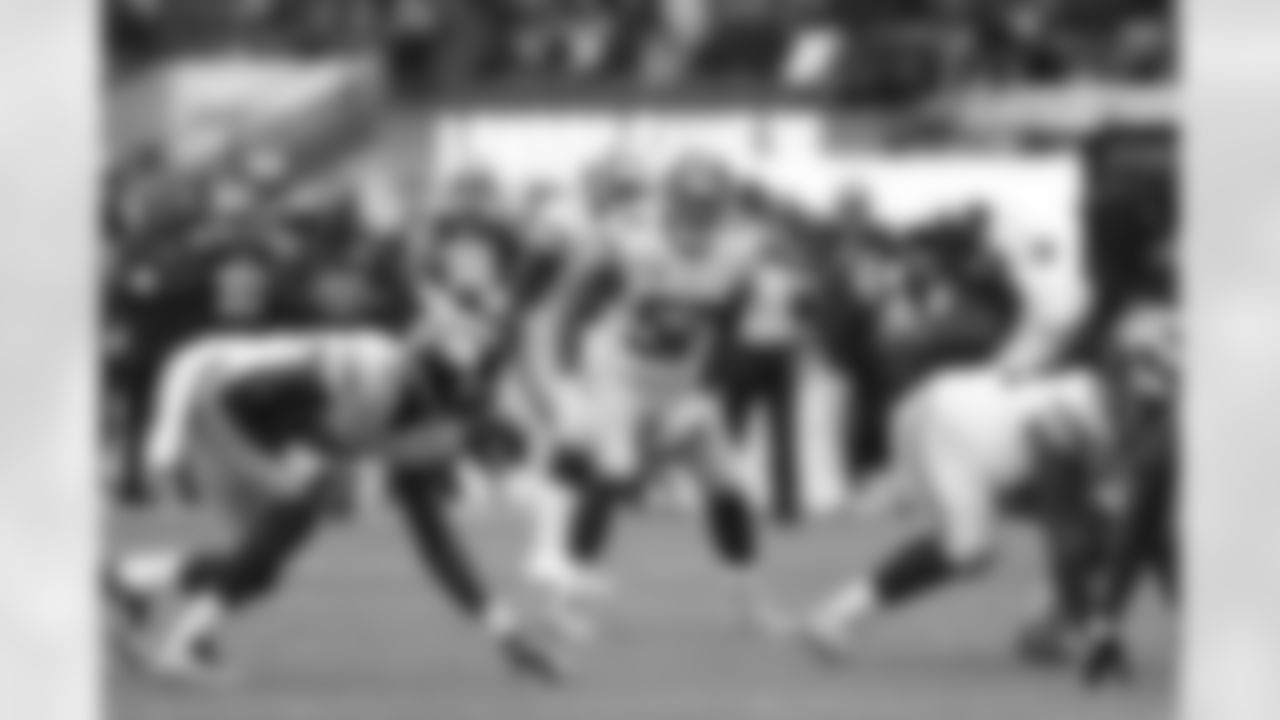
New York Giants outside linebacker Jonathan Casillas (52) lines up prior to the snap during an NFL football game against the Los Angeles Rams on Sunday, Oct. 23, 2016, in London. New York won 17-10. (Aaron M. Sprecher via AP)

Los Angeles Rams quarterback Case Keenum (17) throws the ball during an NFL football game against the New York Giants at Twickenham Stadium on Sunday, Oct. 23, 2016 in London. (Ben Liebenberg via AP)

New York Giants defensive tackle Damon Harrison (98) tackles Los Angeles Rams quarterback Case Keenum (17) during an NFL football game between New York Giants and Los Angeles Rams at Twickenham stadium in London, Sunday Oct. 23, 2016. (AP Photo/Matt Dunham)

New York Giants quarterback Eli Manning (10) receives the snap and looks to throw the ball during an NFL football game against the Los Angeles Rams on Sunday, Oct. 23, 2016, in London. New York won 17-10. (Aaron M. Sprecher via AP)

New York Giants defensive end Jason Pierre-Paul (90) pumps up the crowd during an NFL football game against the Los Angeles Rams at Twickenham Stadium on Sunday, Oct. 23, 2016 in London. (Ben Liebenberg via AP)

New York Giants strong safety Landon Collins (21) returns and interception for a touchdown during a week 7 NFL football game against the Los Angeles Rams on October 23, 2016 in London, U.K. (Evan Pinkus via AP)

Los Angeles Rams wide receiver Tavon Austin (11) evades a tackle by New York Giants outside linebacker Jonathan Casillas (52) during an NFL football game between New York Giants and Los Angeles Rams at Twickenham stadium in London, Sunday Oct. 23, 2016. (AP Photo/Matt Dunham)
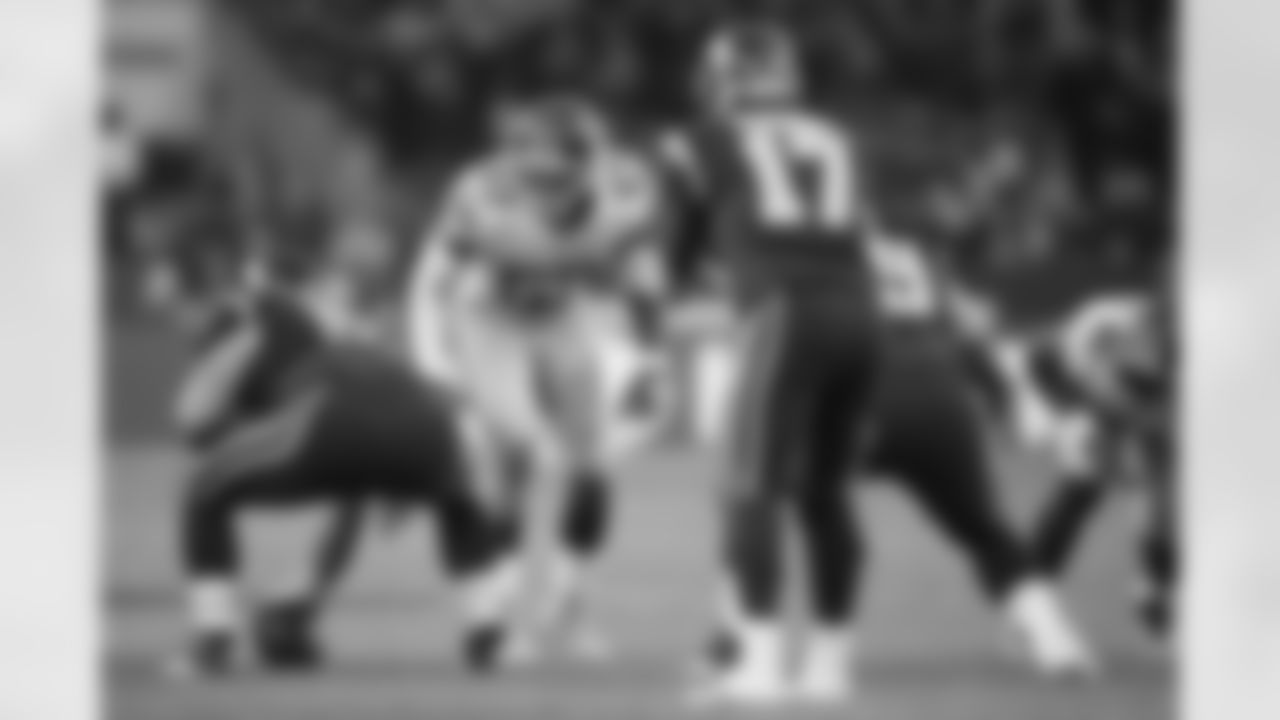
New York Giants linebacker Keenan Robinson (57) lines up in position at the line of scrimmage during an NFL football game against the Los Angeles Rams at Twickenham Stadium on Sunday, Oct. 23, 2016 in London. (Ben Liebenberg via AP)

New York Giants quarterback Eli Manning (10) throws the ball during an NFL football game against the Los Angeles Rams at Twickenham Stadium on Sunday, Oct. 23, 2016 in London. (Ben Liebenberg via AP)

Los Angeles Rams quarterback Case Keenum (17) is hit by New York Giants defensive end Jason Pierre-Paul (90) during an NFL football game at Twickenham Stadium on Sunday, Oct. 23, 2016 in London. (Ben Liebenberg via AP)

New York Giants strong safety Landon Collins (21) returns and interception for a touchdown during a week 7 NFL football game against the Los Angeles Rams on October 23, 2016 in London, U.K. (Evan Pinkus via AP)

New York Giants quarterback Eli Manning (10) throws the ball during an NFL football game against the Los Angeles Rams on Sunday, Oct. 23, 2016, in London. New York won 17-10. (Aaron M. Sprecher via AP)

The New York Giants offensive line lines up across from the Los Angeles Rams defensive line during an NFL football game on Sunday, Oct. 23, 2016, in London. New York won 17-10. (Aaron M. Sprecher via AP)

New York Giants line up to sing the national anthem before an NFL football game between New York Giants and Los Angeles Rams at Twickenham stadium in London, Sunday Oct. 23, 2016. (AP Photo/Matt Dunham)

Los Angeles Rams quarterback Case Keenum (17) prepares to throw the ball during an NFL football game between New York Giants and Los Angeles Rams at Twickenham stadium in London, Sunday Oct. 23, 2016. (AP Photo/Matt Dunham)

New York Giants wide receiver Sterling Shepard (87) runs after the catch in front of Los Angeles Rams cornerback Troy Hill (32) during an NFL football game at Twickenham Stadium on Sunday, Oct. 23, 2016 in London. (Ben Liebenberg via AP)

New York Giants quarterback Eli Manning (10) during a week 7 NFL football game against the Los Angeles Rams on October 23, 2016 in London, U.K. (Evan Pinkus via AP)

New York Giants cornerback Dominique Rodgers-Cromartie (41) intercepts a pass in the end zone during an NFL football game against the Los Angeles Rams at Twickenham Stadium on Sunday, Oct. 23, 2016 in London. (Ben Liebenberg via AP)

New York Giants wide receiver Victor Cruz (80) evades a tackle by Los Angeles Rams running back Benny Cunningham (23) during an NFL football game between New York Giants and Los Angeles Rams at Twickenham stadium in London, Sunday Oct. 23, 2016. (AP Photo/Matt Dunham)

New York Giants defensive end Jason Pierre-Paul (90) hits Los Angeles Rams quarterback Case Keenum (17) during an NFL football game on Sunday, Oct. 23, 2016, in London. New York won 17-10. (Aaron M. Sprecher via AP)

New York Giants wide receiver Sterling Shepard (87) evades a tackle from Los Angeles Rams cornerback Troy Hill (32) during an NFL football game between New York Giants and Los Angeles Rams at Twickenham stadium in London, Sunday Oct. 23, 2016. (AP Photo/Matt Dunham)

New York Giants wide receiver Victor Cruz (80) walks on the field before an NFL football game between New York Giants and Los Angeles Rams at Twickenham stadium in London, Sunday Oct. 23, 2016. (AP Photo/Matt Dunham)

New York Giants wide receiver Victor Cruz (80) runs after a catch during an NFL football game against the Los Angeles Rams on Sunday, Oct. 23, 2016, in London. New York won 17-10. (Aaron M. Sprecher via AP)

New York Giants strong safety Landon Collins (21), centre, runs through before scoring a touchdown during an NFL football game against Los Angeles Rams at Twickenham stadium in London, Sunday Oct. 23, 2016. (AP Photo/Tim Ireland)

New York Giants quarterback Eli Manning (10) celebrates after leading his team to a touchdown during an NFL football game against the Los Angeles Rams on Sunday, Oct. 23, 2016, in London. New York won 17-10. (Aaron M. Sprecher via AP)

New York Giants wide receiver Sterling Shepard (87) runs after the catch during an NFL football game against the Los Angeles Rams at Twickenham Stadium on Sunday, Oct. 23, 2016 in London. (Ben Liebenberg via AP)

New York Giants wide receiver Victor Cruz (80) runs the ball during an NFL football game against the Los Angeles Rams at Twickenham Stadium on Sunday, Oct. 23, 2016 in London. (Ben Liebenberg via AP)

New York Giants tight end Will Tye (45) is tackled by Los Angeles Rams middle linebacker Alec Ogletree (52) during an NFL football game between New York Giants and Los Angeles Rams at Twickenham stadium in London, Sunday Oct. 23, 2016. (AP Photo/Matt Dunham)

New York Giants coach Tom Coughlin runs onto the field before a game against the Miami Dolphins at Wembley Stadium, London, Sunday, Oct. 28, 2007. (AP Photo/Tom Hevezi)

New York Giants qb Eli Manning calls signals against the Miami Dolphins during their NFL football game at Wembley Stadium, London, Sunday, Oct. 28, 2007. (AP Photo/Tom Hevezi)

Miami Dolphins qb Cleo Lemon (17) throws a pass against the New York Giants R.W. McQuaters (25) during their NFL football game at Wembley Stadium, London, Sunday, Oct. 28, 2007. (AP Photo/Tom Hevezi)

LONDON - OCTOBER 28: Safety Michael Johnson #43 of the New York Giants waits for the Miami Dolphins snap on October 28, 2007 in London, England. This is the first ever regular season NFL match to be played outside of the United States. The Giants won the game 13-10. (AP Photo/Thomas E. Witte) Michael Johnson

LONDON - OCTOBER 28: Running back Reuben Droughns #22 of the New York Giants can't get past the Miami Dolphins defensive line on October 28, 2007 in London, England. This is the first ever regular season NFL match to be played outside of the United States. The Giants won the game 13-10. (AP Photo/Thomas E. Witte) Reuben Droughns

LONDON - OCTOBER 28: Quarterback Cleo Lemon #17 of the Miami Dolphins attempts to pass against the New York Giants on October 28, 2007 in London, England. This was the first ever regular season NFL match to be played outside of the United States. The Giants won the game 13-10. (AP Photo/Thomas E. Witte) Cleo Lemon

LONDON - OCTOBER 28: Quarterback Eli Manning #10 of the New York Giants shouts out play calls against the Miami Dolphins on October 28, 2007 in London, England. This is the first ever regular season NFL match to be played outside of the United States. The Giants won the game 13-10. (AP Photo/Thomas E. Witte) Eli Manning

LONDON - OCTOBER 28: The New York Giants against the Miami Dolphins on October 28, 2007 in London, England. This is the first ever regular season NFL match to be played outside of the United States. The Giants won the game 13-10. (AP Photo/Thomas E. Witte)

LONDON - OCTOBER 28: Quarterback Eli Manning #10 of the New York Giants shouts out play calls against the Miami Dolphins on October 28, 2007 in London, England. This is the first ever regular season NFL match to be played outside of the United States. The Giants won the game 13-10. (AP Photo/Thomas E. Witte) Eli Manning

LONDON - OCTOBER 28: Tight end Jeremy Shockey #80 of the New York Giants is brought down by Will Allen #25 of the Miami Dolphins on October 28, 2007 in London, England. This is the first ever regular season NFL match to be played outside of the United States. The Giants won the game 13-10. (AP Photo/Thomas E. Witte) Jeremy Shockey, WIll Allen

LONDON - OCTOBER 28: Quarterback Cleo Lemon #17 of the Miami Dolphins drops back to pass against the New York Giants on October 28, 2007 in London, England. This was the first ever regular season NFL match to be played outside of the United States. The Giants won the game 13-10. (AP Photo/Thomas E. Witte) Cleo Lemon
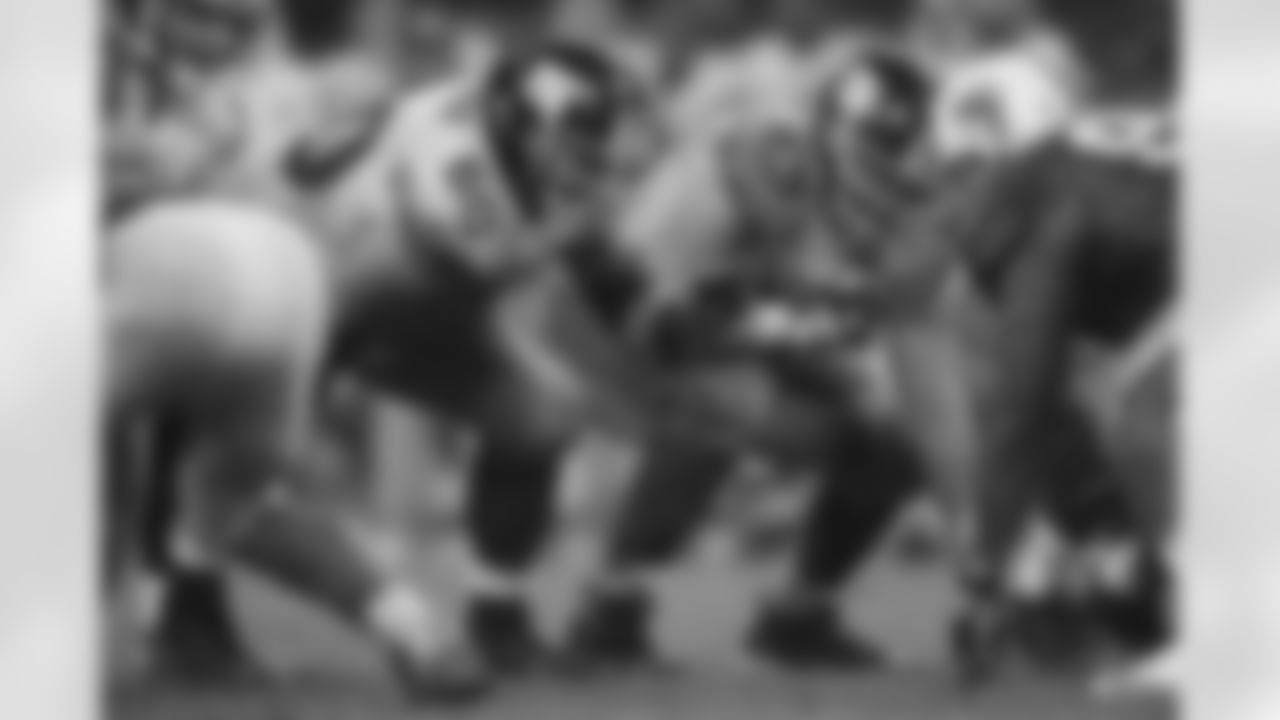
LONDON - OCTOBER 28: Center Shaun O'Hara #60 of the New York Giants against the Miami Dolphins on October 28, 2007 in London, England. This is the first ever regular season NFL match to be played outside of the United States. The Giants won the game 13-10. (AP Photo/Thomas E. Witte) Shaun O'Hara

LONDON - OCTOBER 28: Running back Brandon Jacobs #27 of the New York Giants rushes for a solid gain against the Miami Dolphins on October 28, 2007 in London, England. This is the first ever regular season NFL match to be played outside of the United States. The Giants won the game 13-10. (AP Photo/Thomas E. Witte) Brandon Jacobs

LONDON - OCTOBER 28: Running back Brandon Jacobs #27 of the New York Giants rushes for a solid gain against the Miami Dolphins on October 28, 2007 in London, England. This is the first ever regular season NFL match to be played outside of the United States. The Giants won the game 13-10. (AP Photo/Thomas E. Witte) Brandon Jacobs

LONDON - OCTOBER 28: Corner back R.W. McQuarters #25 of the New York Giants returns an interception against the Miami Dolphins on October 28, 2007 in London, England. This is the first ever regular season NFL match to be played outside of the United States. The Giants won the game 13-10. (AP Photo/Thomas E. Witte) R.W. McQuarters

LONDON - OCTOBER 28: Corner back R.W. McQuarters #25 of the New York Giants returns an interception against the Miami Dolphins on October 28, 2007 in London, England. This is the first ever regular season NFL match to be played outside of the United States. The Giants won the game 13-10. (AP Photo/Thomas E. Witte) R.W. McQuarters

LONDON - OCTOBER 28: Quarterback Eli Manning #10 of the New York Giants rushes for a touchdown against the Miami Dolphins on October 28, 2007 in London, England. This is the first ever regular season NFL match to be played outside of the United States. The Giants won the game 13-10. (AP Photo/Thomas E. Witte) Eli Manning

LONDON - OCTOBER 28: Quarterback Eli Manning #10 of the New York Giants shouts out play calls against the Miami Dolphins on October 28, 2007 in London, England. This is the first ever regular season NFL match to be played outside of the United States. The Giants won the game 13-10. (AP Photo/Thomas E. Witte) Eli Manning

LONDON - OCTOBER 28: Quarterback Eli Manning #10 of the New York Giants shouts out play calls against the Miami Dolphins on October 28, 2007 in London, England. This is the first ever regular season NFL match to be played outside of the United States. The Giants won the game 13-10. (AP Photo/Thomas E. Witte) Eli Manning

LONDON - OCTOBER 28: Guard Rich Seubert #69 of the New York Giants pulls in a Giants fumble against the Miami Dolphins on October 28, 2007 in London, England. This is the first ever regular season NFL match to be played outside of the United States. The Giants won the game 13-10. (AP Photo/Thomas E. Witte) Rich Seubert

New York Giants Michael Strahan (92) recovers a fumble by the Miami Dolphins Cleo Lemon (17) during their NFL football game at Wembley Stadium in London, Sunday, Oct. 28, 2007. The game was the first NFL regular season game played in Europe. (AP Photo/Kirsty Wigglesworth)

New York Giants Brandon Jacobs (27) is hit by Miami Dolphins Michael Lehan (22) during their NFL football game at Wembley Stadium in London, Sunday, Oct. 28, 2007. The game was the first NFL regular season game played in Europe. (AP Photo/Kirsty Wigglesworth)

New York Giants Brandon Jacobs (27) runs away from the Miami Dolphins Channing Crowder (52) during their NFL football game at Wembley Stadium in London, Sunday, Oct. 28, 2007. The game was the first NFL regular season game played in Europe. (AP Photo/Kirsty Wigglesworth)

New York Giants Fred Robbins (98) bears down on Miami Dolphins QB Cleo Lemon (17) during their NFL football game at Wembley Stadium in London, Sunday, Oct. 28, 2007. The game was the first NFL regular season game played in Europe. (AP Photo/Kirsty Wigglesworth)

FILE New York Giants' Brandon Jacobs (27) is tackled by Miami Dolphins' Channing Crowder (52 ) during the second quarter of an NFL football game at Wembley Stadium in London on Oct. 28, 2007. Jacobs and his Giants teammates face the Dallas Cowboys on Sunday, Nov. 11. (AP Photo/Kirsty Wigglesworth)

New York Giants Reuben Droughns (22) runs against the Miami Dolphins during their NFL football game at Wembley Stadium in London, Sunday, Oct. 28, 2007. The game was the first NFL regular season game played in Europe. (AP Photo/Kirsty Wigglesworth)

New York Giants' R.W. McQuarters (25) is chased by Miami Dolphins' Donnie Spragan (59) and John Denney (92) during the fourth quarter of their NFL football game at Wembley Stadium in London, Sunday, Oct. 28, 2007. (AP Photo/Kirsty Wigglesworth)

New York Giants' Sam Madison (29) and Miami Dolphins' Derek Hagan (82) leap for the ball during the third quarter of their NFL football game at Wembley Stadium in London, Sunday, Oct. 28, 2007. (AP Photo/Kirsty Wigglesworth)

New York Giants center Weston Richburg (70) prepares to snap the ball to quarterback Eli Manning (10) during an NFL football game against the Los Angeles Rams on Sunday, Oct. 23, 2016, in London. New York won 17-10. (Aaron M. Sprecher via AP)

New York Giants' R.W. McQuarters (25) is pulled down by Miami Dolphins Jesse Chatman during the third quarter of their NFL football game at Wembley Stadium in London, Sunday, Oct. 28, 2007. (AP Photo/Kirsty Wigglesworth)

New York Giants quarterback Eli Manning (10) warms up before an NFL football game between New York Giants and Los Angeles Rams at Twickenham stadium in London, Sunday Oct. 23, 2016. (AP Photo/Matt Dunham)

New York Giants' quarterback Eli Manning, left, is congratulated by a member of the coaching staff after scoring a touchdown against Miami Dolphins in the second quarter of their NFL football game at Wembley Stadium, London, Sunday, Oct. 28, 2007. (AP Photo/Tom Hevezi)

The New York Giants take the field to face the Miami Dolphins in their NFL football game at Wembley Stadium, London, Sunday, Oct. 28, 2007. (AP Photo/Tom Hevezi)

New York Giants' Fred Robbins (98) tackles Miami Dolphins quarterback Cleo Lemon (17) in the third quarter of their NFL football game at Wembley Stadium, London, Sunday, Oct. 28, 2007. (AP Photo/Tom Hevezi)

New York Giants' Plaxico Burress (17) is tackled by Miami Dolphins' Michael Lehan (22) in the firrst quarter of their NFL football game at Wembley Stadium, London, Sunday, Oct. 28, 2007. (AP Photo/Tom Hevezi)

New York Giants players practice during a walk-through at Wembley Stadium in London, Saturday, Oct. 27, 2007. The Giants are in London for Sunday's game against the Miami Dolphins, the first regular season NFL game outside North America. (AP Photo/Akira Suemori)

A view of the field ahead of New York Giants' walk-through at Wembley Stadium in London, Saturday, Oct. 27, 2007. The New York Giants will play the Miami Dolphins there on Sunday 28 Oct., in the first trans-Atlantic regular-season game in NFL history. (AP Photo/Akira Suemori)

New York Giants tight end Kevin Boss, second right, and his teammates look at the field during a walk-through at Wembley Stadium in London, Saturday, Oct. 27, 2007. The Giants are in London for Sunday's game against the Miami Dolphins, the first regular season NFL game outside North America. (AP Photo/Akira Suemori)

New York Giants players practice during a walk-through at Wembley Stadium in London, Saturday, Oct. 27, 2007. The Giants are in London for Sunday's game against the Miami Dolphins, the first regular season NFL game outside North America. (AP Photo/Akira Suemori)
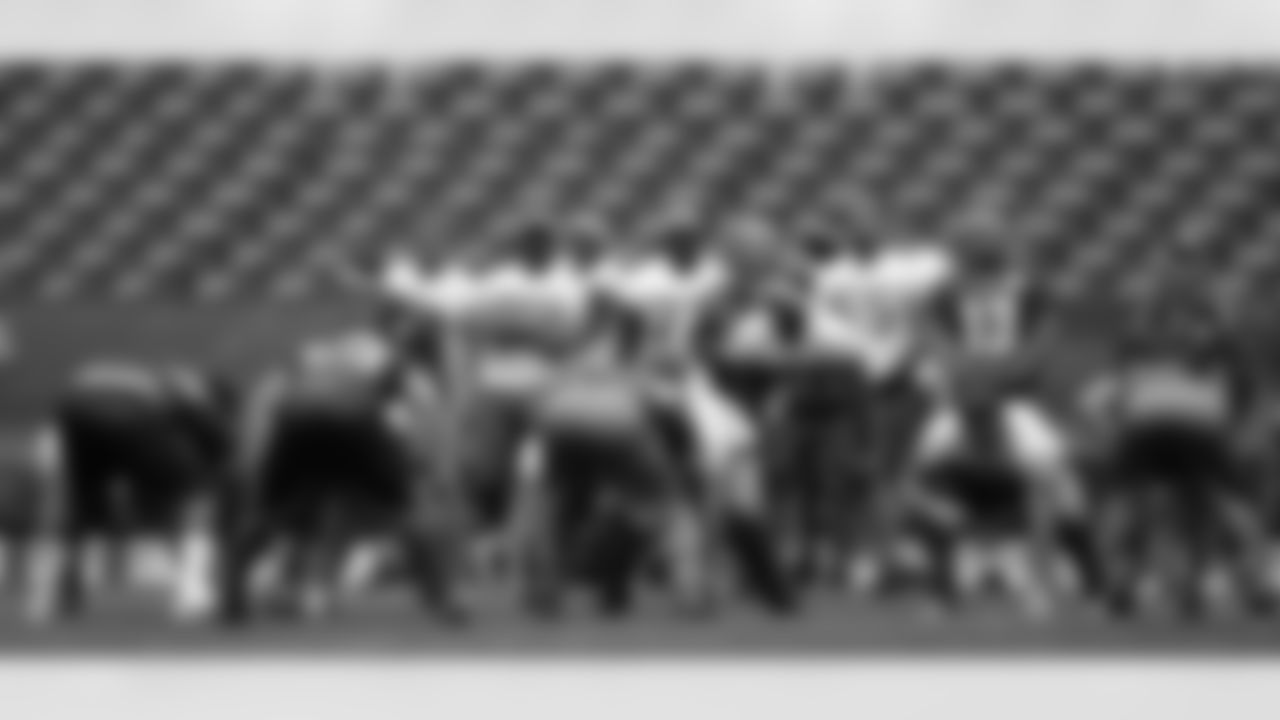
New York Giants players practice during a walk-through at Wembley Stadium in London, Saturday, Oct. 27, 2007. The Giants are in London for Sunday's game against the Miami Dolphins, the first regular season NFL game outside North America. (AP Photo/Akira Suemori)

New York Giants Head Coach Tom Coughlin looks at his players on the field during a walk-through at Wembley Stadium in London, Saturday, Oct. 27, 2007. The Giants are in London for Sunday's game against the Miami Dolphins, the first regular season NFL game outside North America. (AP Photo/Akira Suemori)

New York Giants safety Michael Johnson, center, smiles as he practices with his teammates during a walk-through at Wembley Stadium in London, Saturday, Oct. 27, 2007. The Giants are in London for Sunday's game against the Miami Dolphins, the first regular season NFL game outside North America. (AP Photo/Akira Suemori)

New York Giants quarterback Eli Manning walks to the field during a walk-through at Wembley Stadium in London, Saturday, Oct. 27, 2007. The Giants are in London for Sunday's game against the Miami Dolphins, the first regular season NFL game outside North America. (AP Photo/Akira Suemori)

New York Giants players practice during a walk-through at Wembley Stadium in London, Saturday, Oct. 27, 2007. The Giants are in London for Sunday's game against the Miami Dolphins, the first regular season NFL game outside North America. (AP Photo/Akira Suemori)

Giants Offensive Huddle

Plaxico Burress pregame

Tom Coughlin

Rich Seubert and Chris Snee pregame

Giants Defense

Osi Umenyiora

Justin Tuck

Michael Strahan pregame huddle

Lawrence Tynes

Antonio Pierce
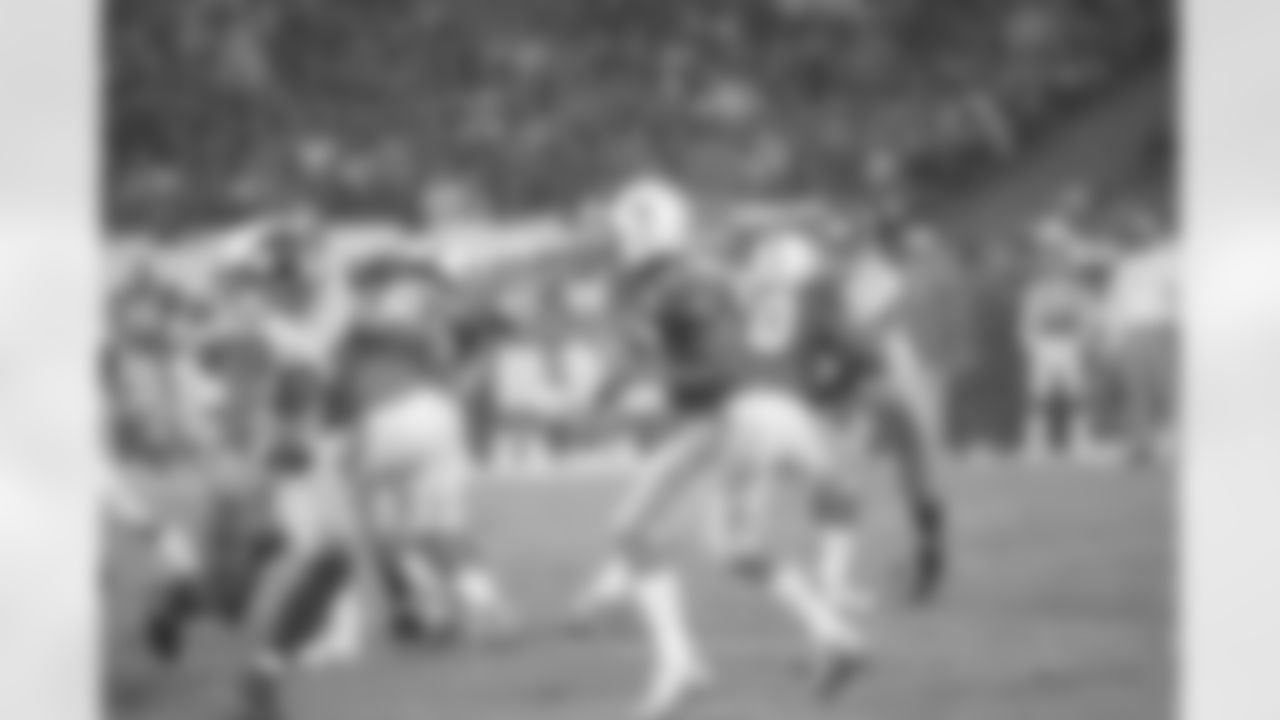
Michael Strahan

Coin Toss

Defensive Coordinator Steve Spagnuolo and Kawika Mitchell

Jeff Feagles

Osi Umenyiora

Osi Umenyiora

Eli Manning

Eli Manning

Eli Manning

Reuben Droughns (22)

Eli Manning and Shaun O'Hara

Jeff Feagles (18)

Brandon Jacobs

Eli Manning

Brandon Jacobs (27)


Carter Coughlin (52)



Jihad Ward (55)

Saquon Barkley (26)

Jihad Ward (55)

Darius Slayton (86)

Daniel Jones (8)

Daniel Jones (8)

Daniel Jones (8)

Daniel Jones (8)
















